Complete Solutions to Taking it together of chapter ELECTROSTATICS of Class 12 book with complete answers and questions
| Class 12 | PHYSICS |
| Chapter | ELECTROSTATICS |
| DC PANDEY NEET | Taking it together |
| Number Of Questions | 100 |
| Academic Year | 2023-24 |
Figure shows the electric lines of force emerging from a charged body. If the electric field at`A` and `B` are `E_(A)` and `E_(B)` respectively and if the displacement between `A` and `B` is `r` then
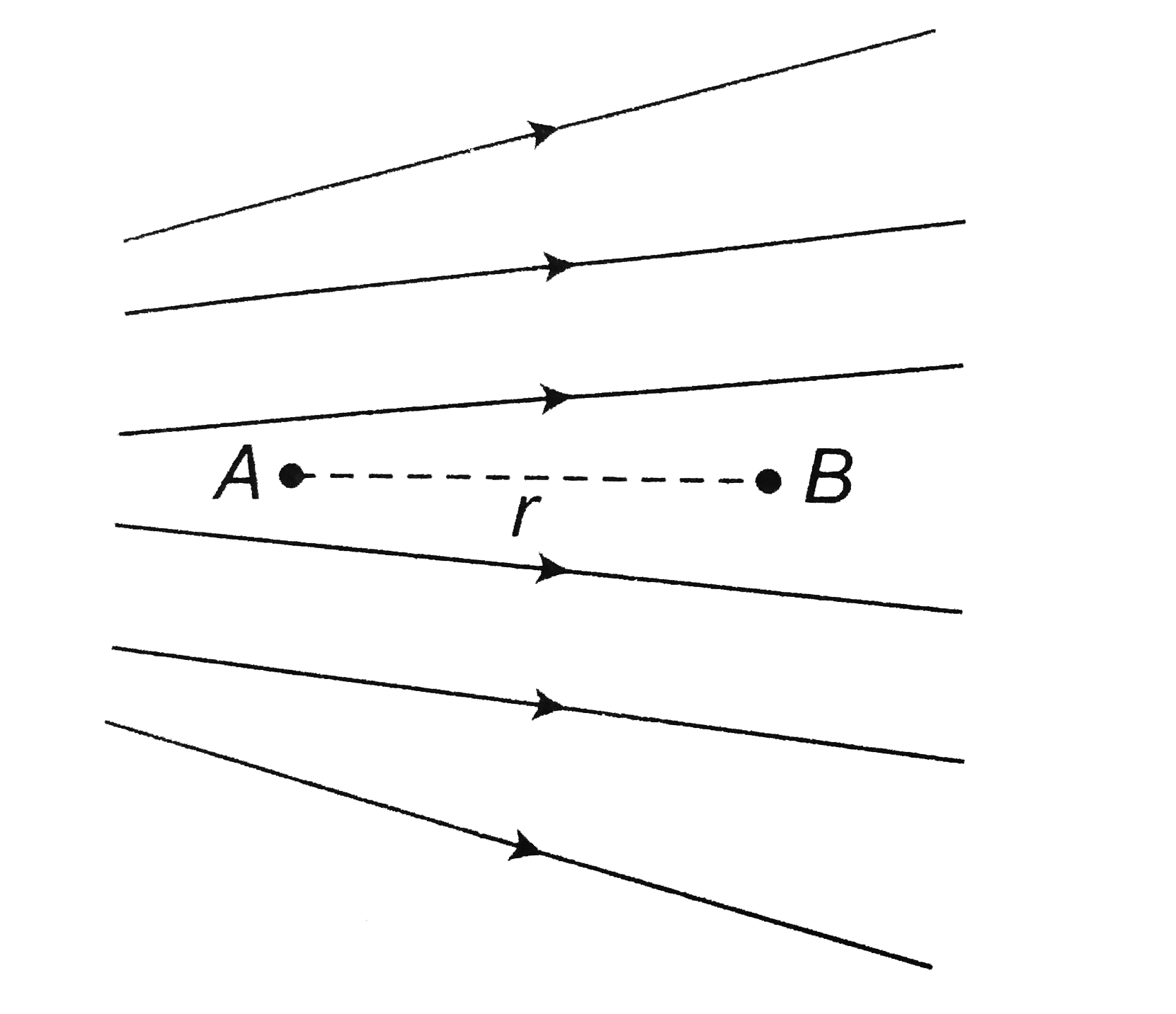
View SolutionThe unit of physical quantity obtained by the line integral of electric field is
View SolutionTwo point charge `+2 C` and `+6 C` repel each other with a force of `12 N` . If a charge of `-4 C` is given to each other of these charges , the force will now be
View SolutionThree equal charges are placed on the three corners of a square. If the force between `q_(1)` and `q_(2)` is `F_(12)` and that between `q_(1)` and `q_(3)` is `F_(13)`, then the ratio of magnitudes `(F_(12)//F_(13))` is
View SolutionThe insulation property of air breaks down at `E=3xx10^(6) "volt"//meter`. The maximum charge that can be given to a sphere of diameter `5m` is approximately (in coulombs)
View SolutionThe electric field near a conducting surface having a uniform surface charge denstiy `sigma` is given by
View SolutionA metallic solid sphere is placed in a uniform electric field. The lines of force follow the path(s) shown in Figure as
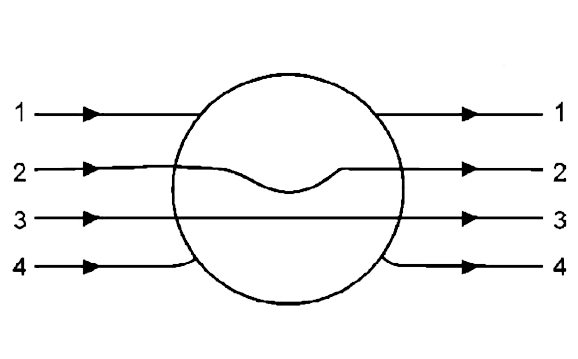
View SolutionA conductor has been given a charge `-3 xx 10^(-7) C` by transferring electron. Mass increase (in kg) of the conductor and the number of electrons added to the conductor are respectively
View SolutionTwo point charges of `20 mu C` and `80 muC` are 10 cm apart where will the electric field strength be zero on the line joining the charges from `20 mu C` charge
View SolutionFor a dipole `q= 2xx10^(-6)C` and `d= 0.01m`. Calculate the maximum torque for this dipole if `E= 5xx10^(5)N//C`
View SolutionWhat is the magnitude of a point charge due to which the electric field `30cm` away the magnitude `2`?
`[1//4 pi epsilon_(0)=9xx10^(9)Nm^(2)//C^(2)]`
View SolutionA dipole of electric dipole moment p is placed in a uniform electric field of strength E. If `theta` is the angle between positive direction of p and E, then the potential energy of the electric dipole is largest when `theta` is
View SolutionThe ratio of electrostatic and gravitational force acting between electron and proton separated by a distance `5 xx 10^(-11)m`, will be (charge on electron `= 1.6 xx 10^(-19)C`, mass of electron `= 9.1 xx 10^(-31) kg`, mass of proton `= 1.6 xx 10^(-27) kg, G = 6.7 xx 10^(-11) N - m^(2)//kg^(2)`)
View SolutionAn electric dipole is placed in an uniform electric field with the dipole axis making an angle `theta` with the direction of the electric field. The orientation of the dipole for stable equilibrium is
View SolutionFigure shows electric field lines in which an electric dipole p is placed as shown. Which of the following statements is correct ?
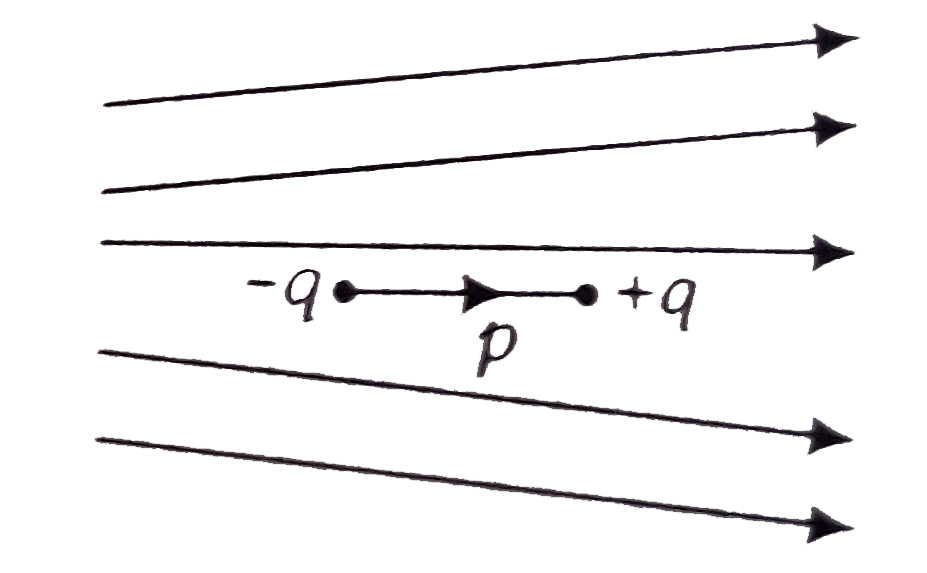
View SolutionTwo similar spheres having `+q` and `-q` charges are kept at a certain distance. The force acts between the two is `F`. If in the middle of two spheres, another similar sphere having `+q` charge is kept,then it experience a force in magnitude and direction as
View SolutionTwo small conducting spheres of equal radius have charges `+ 10 muC` and `-20 muC` respectively and placed at a distance R from each other. They experience force `F_(1)`. If they are brought in contact and separated to the same distance, they experience force `F_(2)`. The ratio of `F_(1)` to `F_(2)` is
View SolutionA charges Q is placed at each of the two opposite corners of a square. A charge q is placed to each of the other two corners. If the resultant force on each charge q is zero, then
View SolutionA point positive charge is brought near an isolated conducting sphere. The electric field is best given by
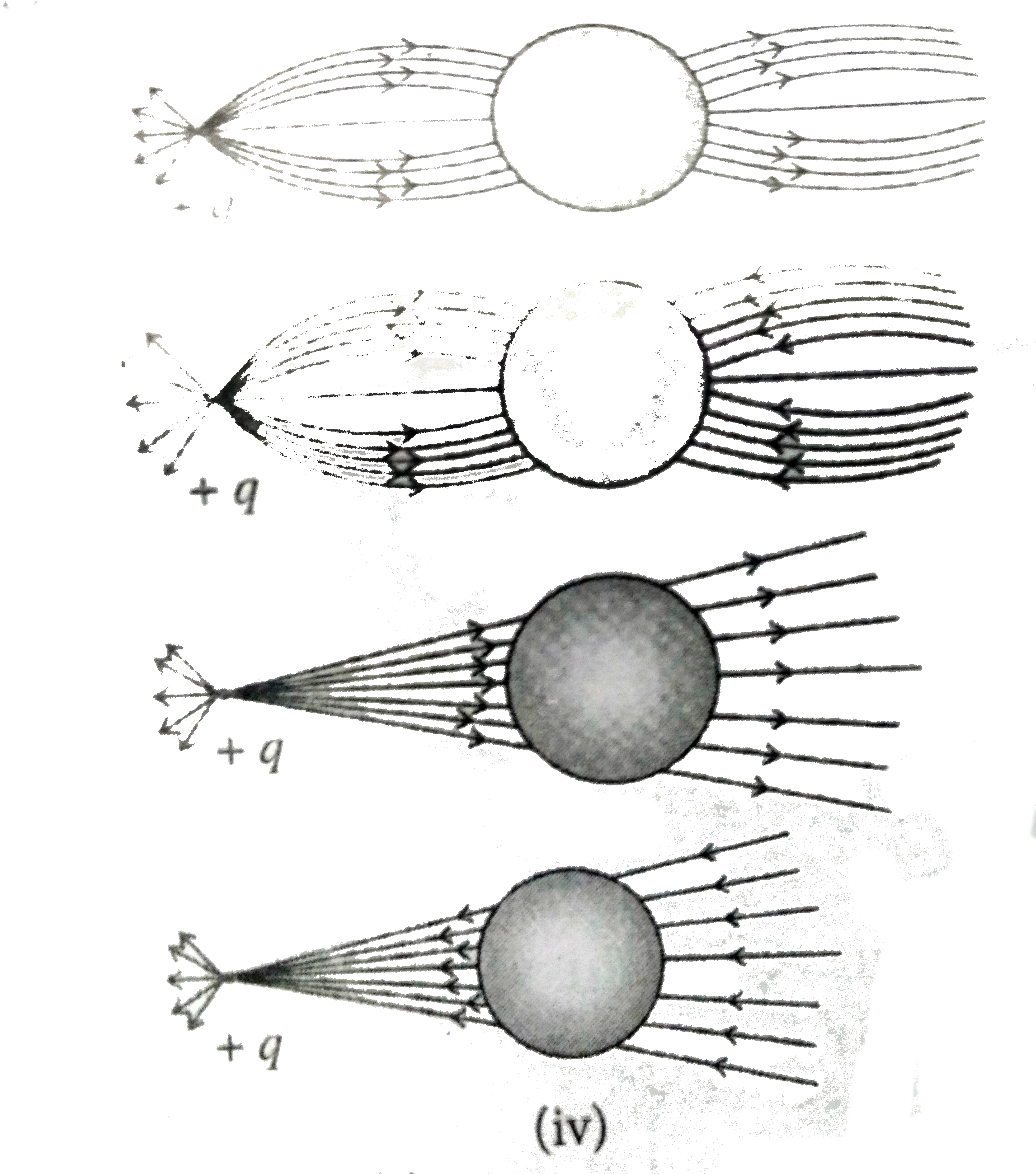
View SolutionA charge q is placed at the centre of the line joining two equal charges Q. The system of the three charges will be in equilibrium if q is equal to:
View SolutionThe centres of two identical small conducting spheres are 1m apart. They carry charge of opposite kind and attract each other with a force F. When they are connected by a conducting thin wire they repel each other with a force `F//3`. What is the ratio of magnitude of charge carried by the sphere initially ?
View SolutionCharges `q, 2q,3q` and `4q` are placed at the corners `A,B,C` and `D` of a square as shown in the following figure. The directon of electric field at the centre of the square is along
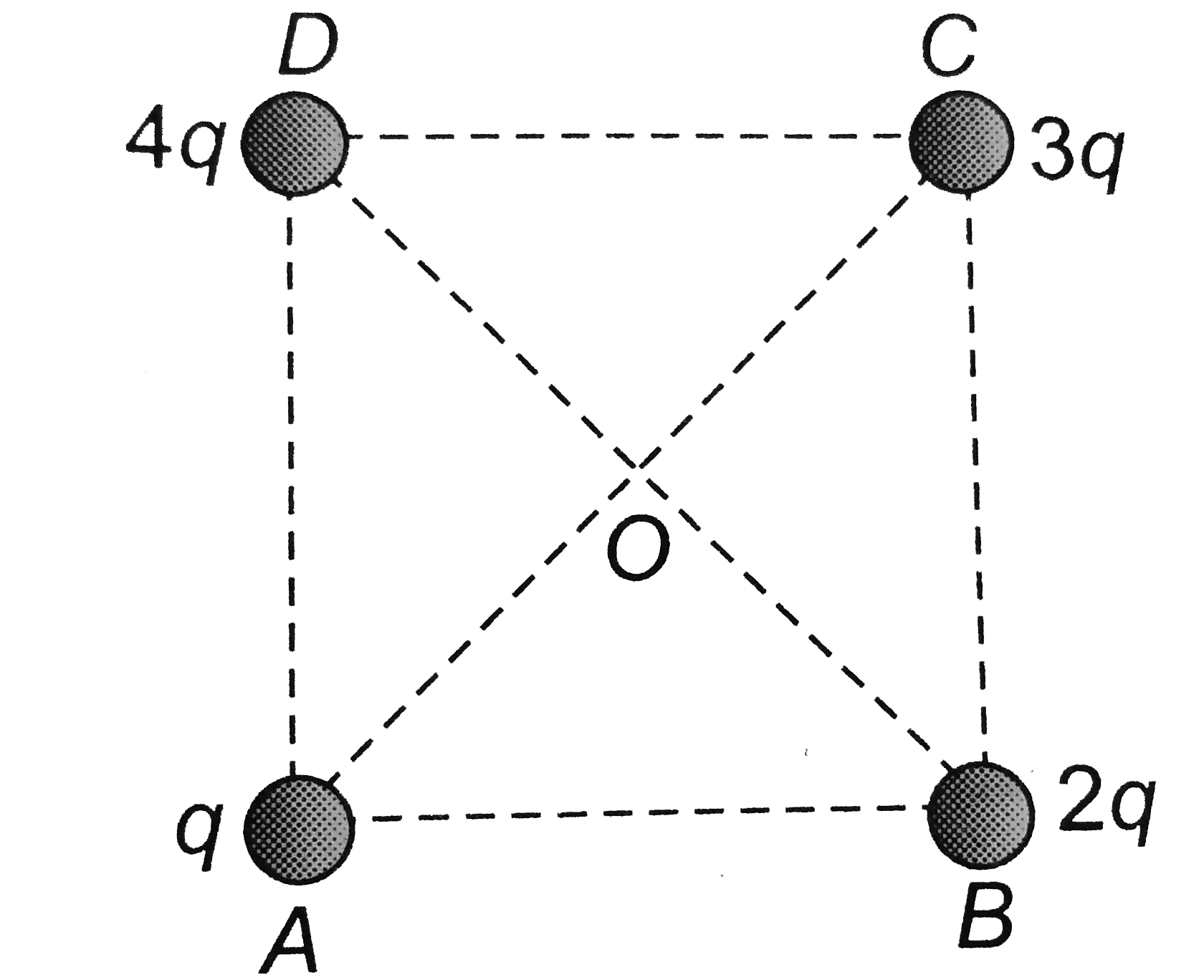
View SolutionA solid conducting sphere of radius `a` has a net positive charge `2Q`. A conducting spherical shell of inner radius `b` and outer radius `c` is concentric with the solid sphere and has a net charge `-Q`. The surface charge density on the inner and outer surfaces of the spherical shell will be
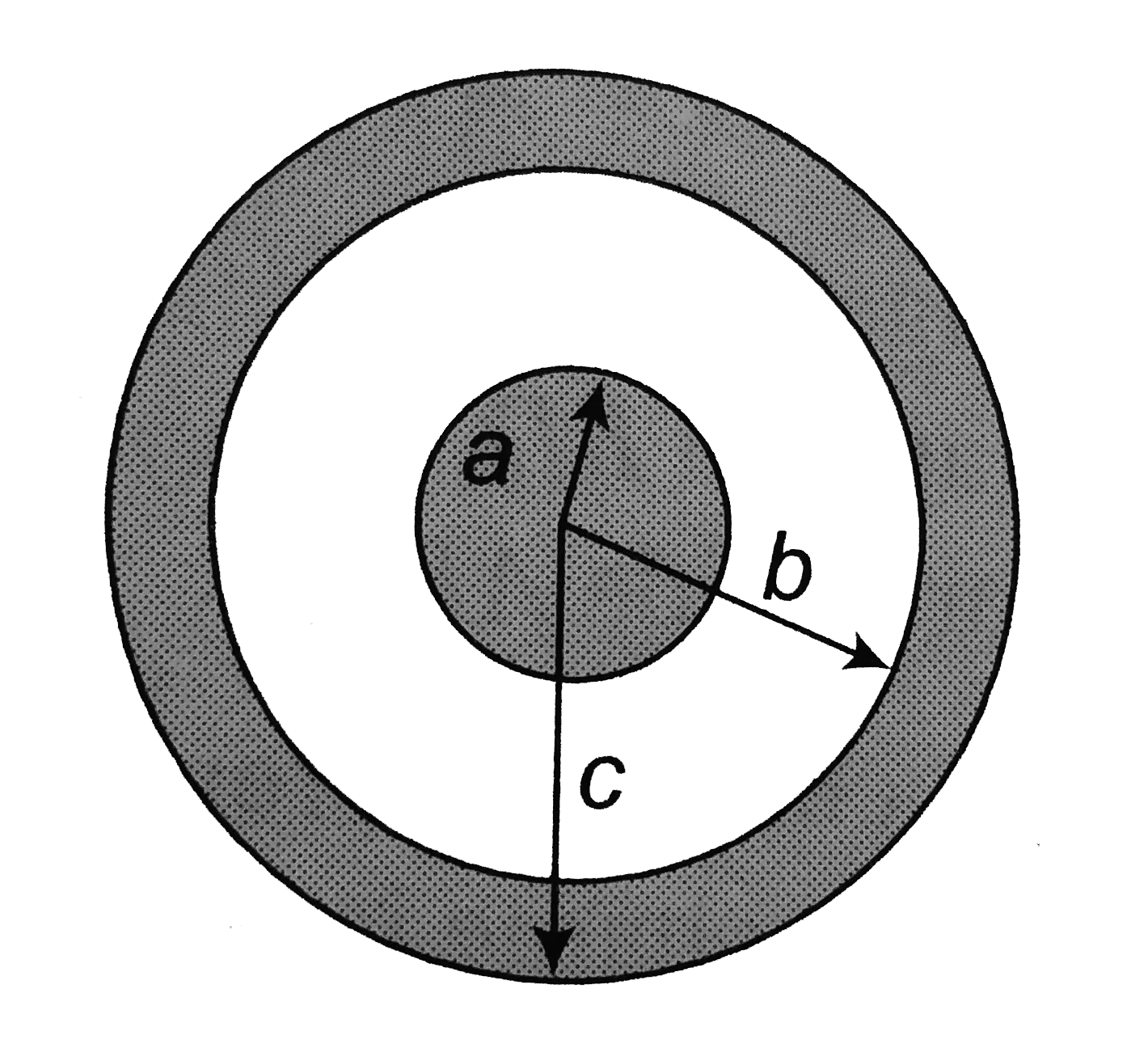
View SolutionThe electric flux through the surface
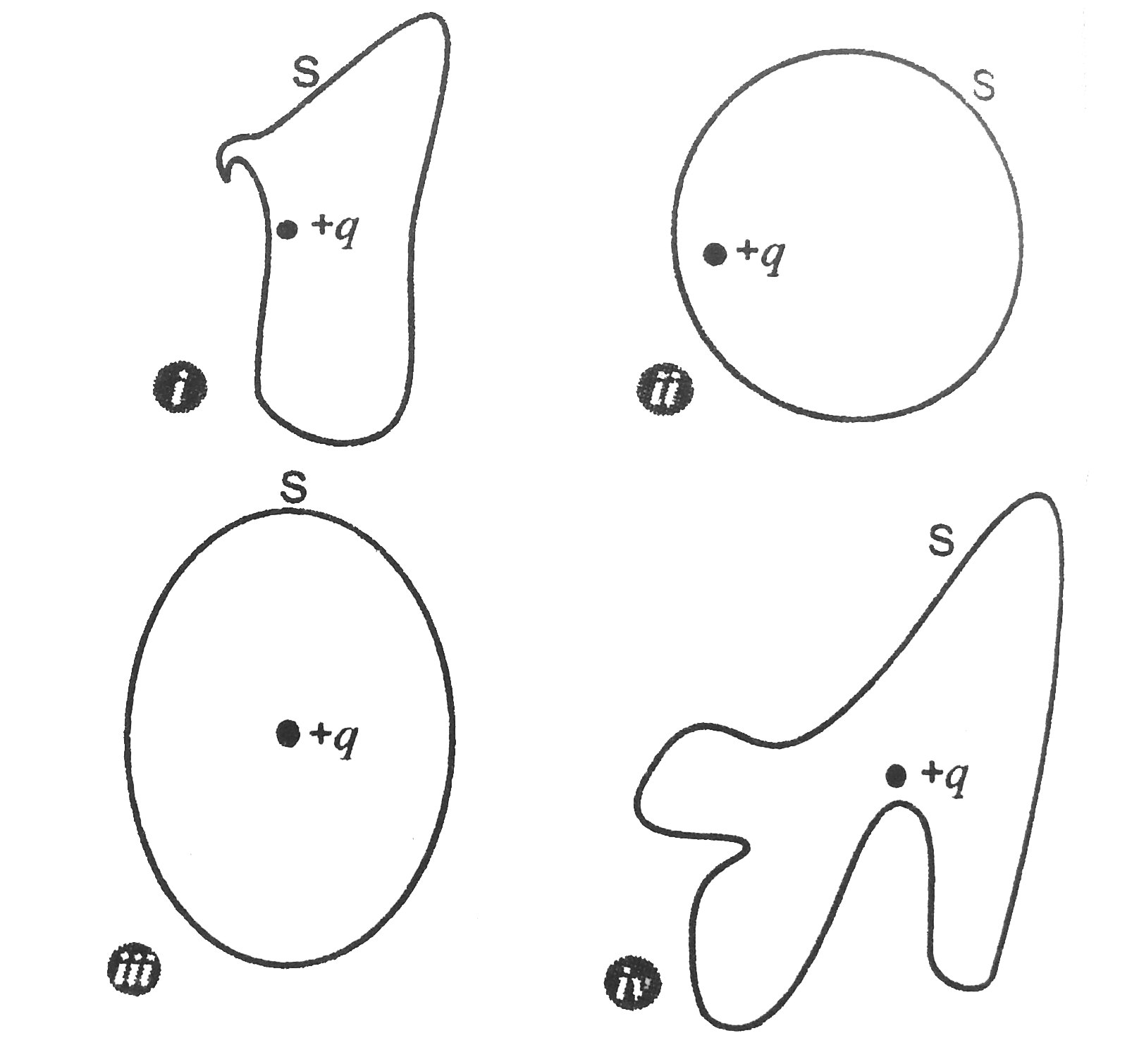
View SolutionThe point charges `Q` and `-2Q` are placed at some distance apart. If the electirc field at the location of `Q` is `E`, the electric field at the location of `-2Q` will be
View SolutionA ball with charge `-50 e` is placed at the centre of a hollow spherical shell has a net charge of `-50e`. What is the charge on the shell's outer surface ?
View SolutionA mass `m=20 g` has a charge `q= 3.0 mC`. It moves with a velocity of 20 m/s and enters a region of electric field of 80 N/C in the same direction as the velocity of the mass. The velocity of the mass after 3 s in this region is
View SolutionTwo parallel metal plates having charges `+Q` and `-Q` face each other at a certain distance between them.If the plates are now dipped in kerosene oil tank ,the electric field between the plates will
View SolutionA square surface of side `L` metre in the plane of the paper is placed in a uniform electric field `E ("volt"//m)` acting along the same place at an anlge `theta` with the horizontal side of the square as shown in figure. The electric flux linked to the surface in uint of `V-m` is
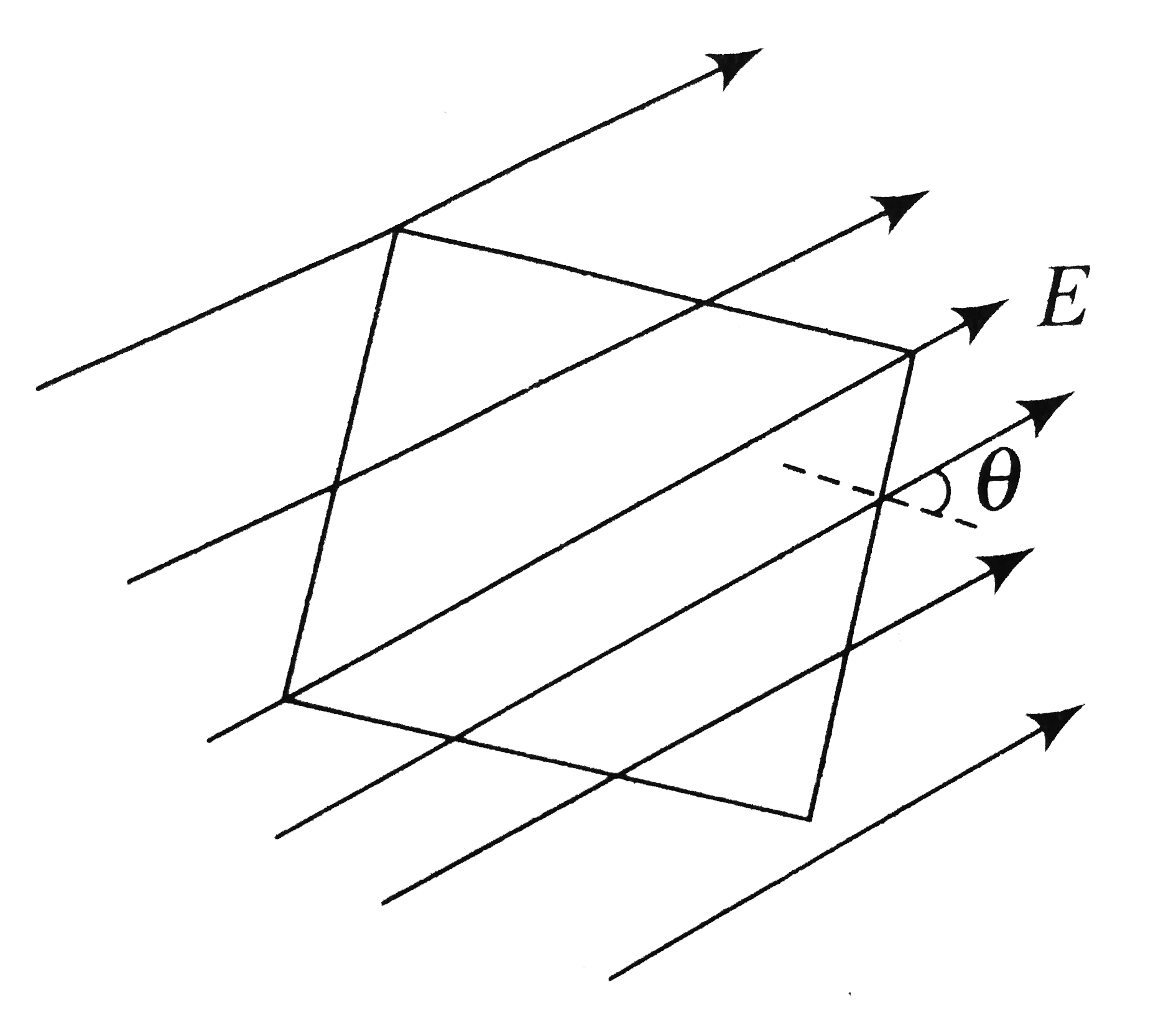
View SolutionThree concentric metallic spherical shells of radii R, 2R, 3R are given charges `Q_(1) Q_(2) Q_(3)`, respectively. It is found that the surface charge densities on the outer surface of the shells are equal. Then, the ratio of the charges given to the shells `Q_(1) : Q_(2) : Q_(3)` is
View SolutionIf a charged particle is projected on a rough horizontal surface with speed `v_(0)`. Find the value of dynamic coefficient of friction, if the kinetic energy of system is constant.
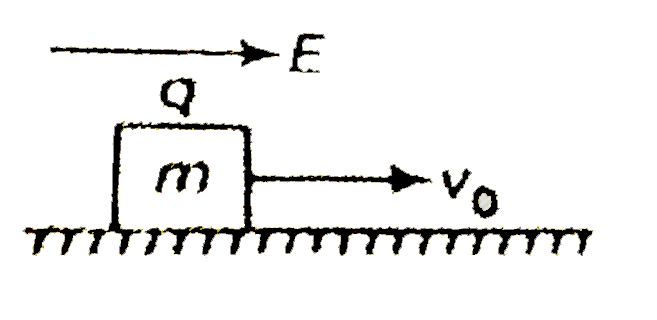
View SolutionElectric charges `q, q, –2q` are placed at the corners of an equilateral triangle ABC of side l. The magnitude of electric dipole moment of the system is
View SolutionA point charge `+q` is placed at a distance `d` from an isolated conducting plane. The field at a point `P` on the other side of plane is
View SolutionA positive point charge `+Q` is fixed in space. A negative point charge `-q` of mass `m` revolves around fixed charge in elliptical orbit. The fixed charge `+Q` is at one focus of the ellipse. The only force acting on negative charge is the electrostic force due to positive charge. Then which of the following statement is true
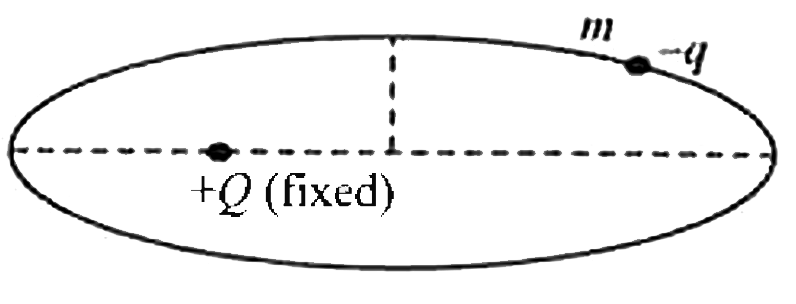
View SolutionTwo identical conducting sphere carrying different charges attact each other with a force F when placed in air medium at a distance `d` apart. The spheres are brought into contact and then taken to their original positions. Now, the two sphere repel each other with a force whole magnitude is equal to the initial attractive force. The ratio between initial charges on the spheres is
View SolutionThe electric field at a distance `3R//2` from the centre of a charge conducting spherical shell of radius `R` is `E`. The electric field at a distance `R//2` from the centre of the sphere is
View SolutionUnder the action of a given coulombic force the acceleration of an electron is `2.5 xx 10^(22) ms^(-1)`. Then, the magnitude of the acceleration of a proton under the action of same force is nearly
View SolutionA drop of `10^(-6)` kg water carries `10^(-6) C` charge. What electric field should be applied to balance its weight (assume `g = 10 ms^(-2)`)
View SolutionIf linear charge density of a wire as shown in the figure is `lambda`
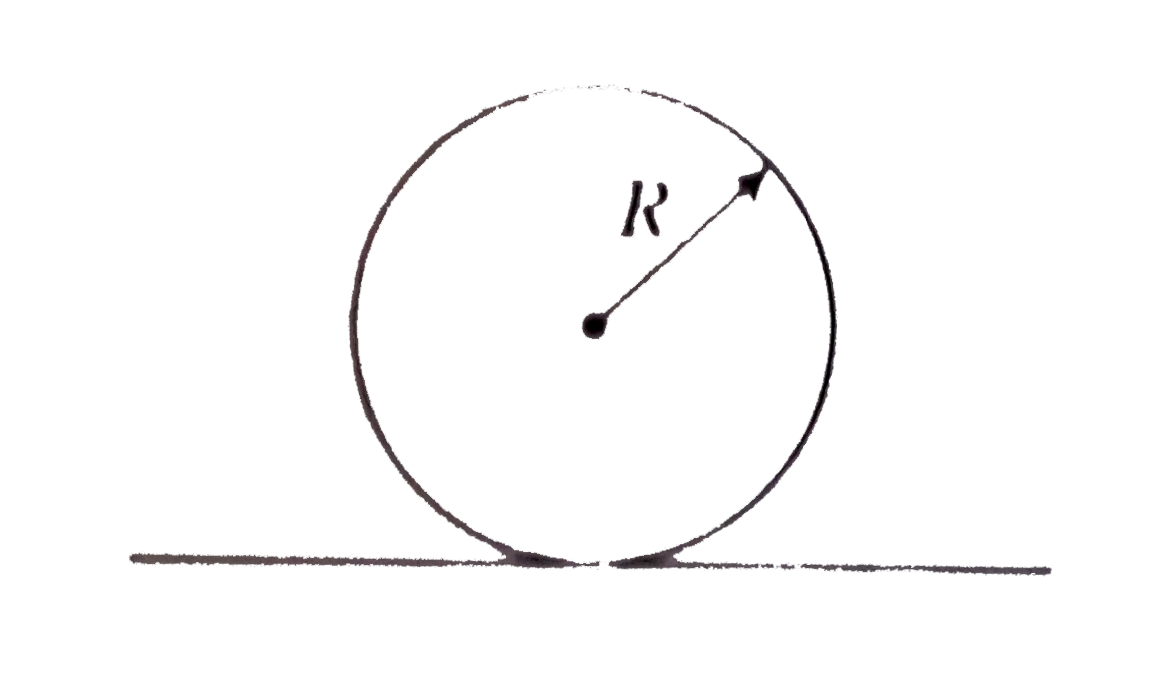
View SolutionFigure below show regular hexagons with charges at the vertices. In which of the following cases the electric field at the centre is not zero
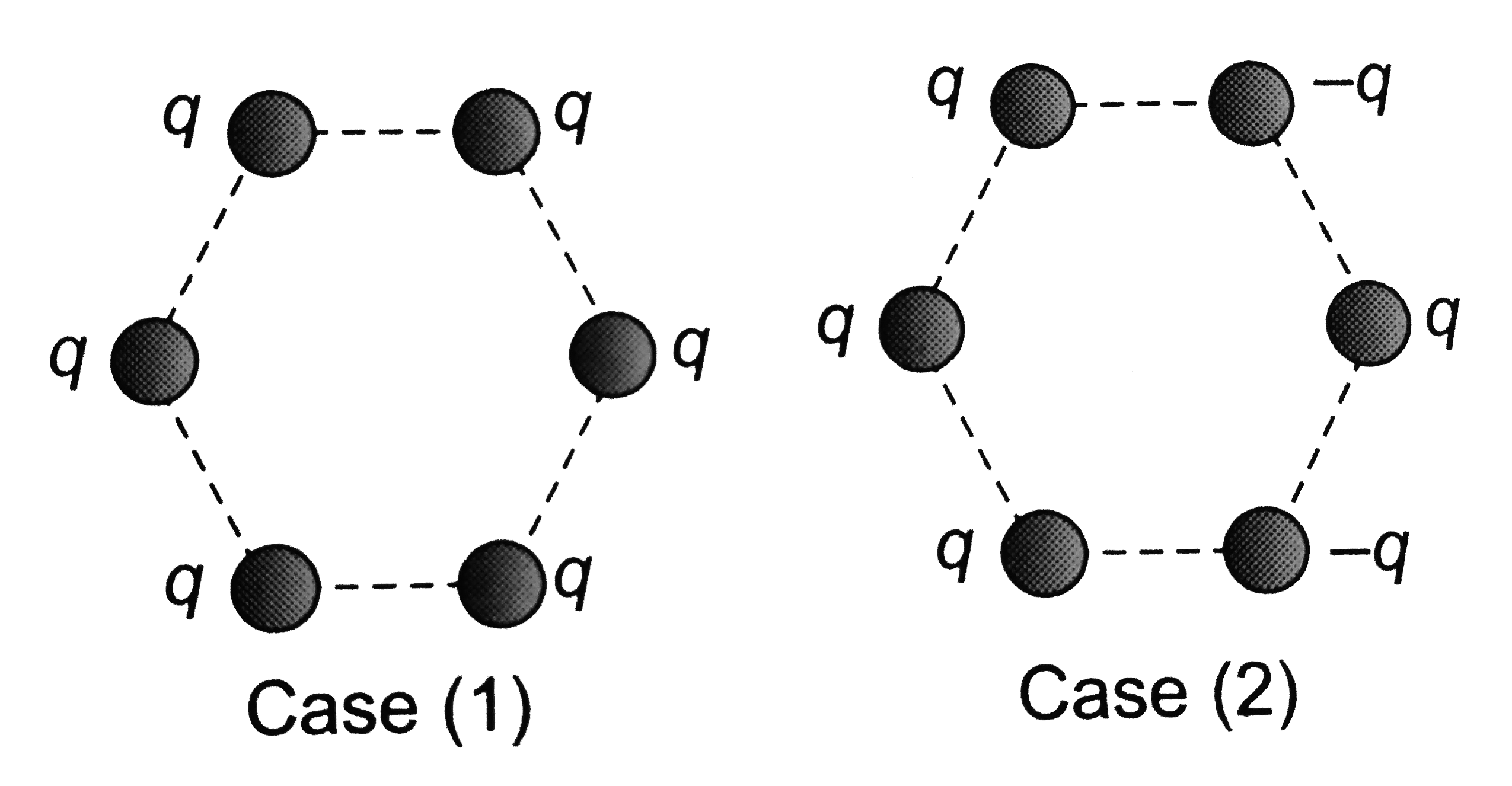
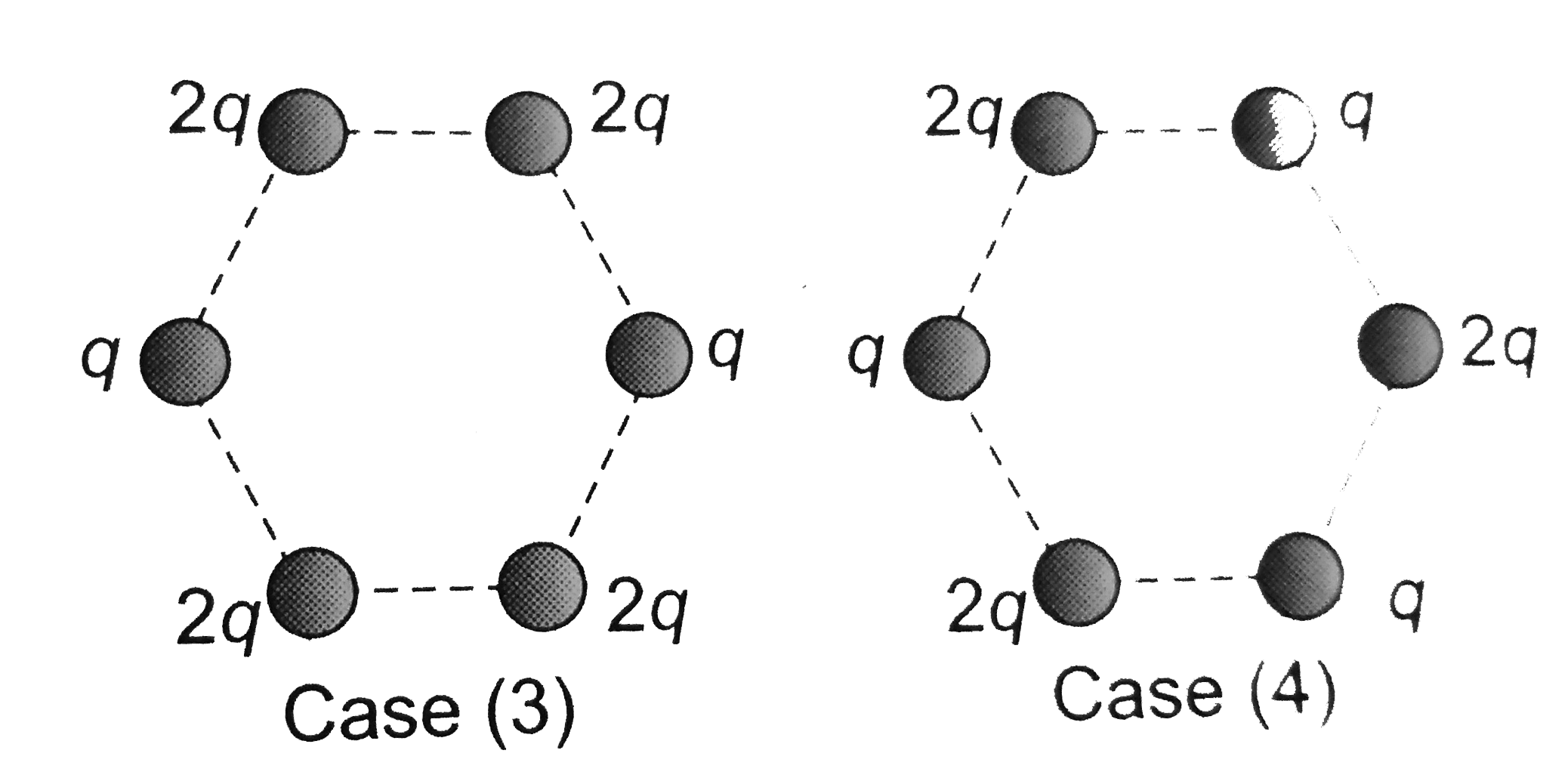
View SolutionElectric field intensity at a point in between two parallel sheets with like charges of same surface charge densities `(sigma)` is
View SolutionThe electric charges are distributed in a small volume. The flux of the electric field through a spherica surface of radius 10 cm surrounding the total charge is `20 V - m`. The flux over a concentric sphere of radius 20 cm will be
View SolutionTwo charges of `-4 muC and +4muC` are placed at the points `A (1,0,4) and B (2,-1,5)` location in an electric field `vec(E) = 0.20 hat(i) V//cm`. Calculate the torque acting on the dipole.
View SolutionAn infinite line charge produces a field of `7.182 xx 10^(8) N//C` at distance of 2 cm. the linear charge density is
View SolutionThe figure shows the path of a positively charged particle `1` through a rectangualr region of unifrom electric field as shown in the figure. What is the direction of electric field and the direction of deflection of particles `2, 3` and `4` ?
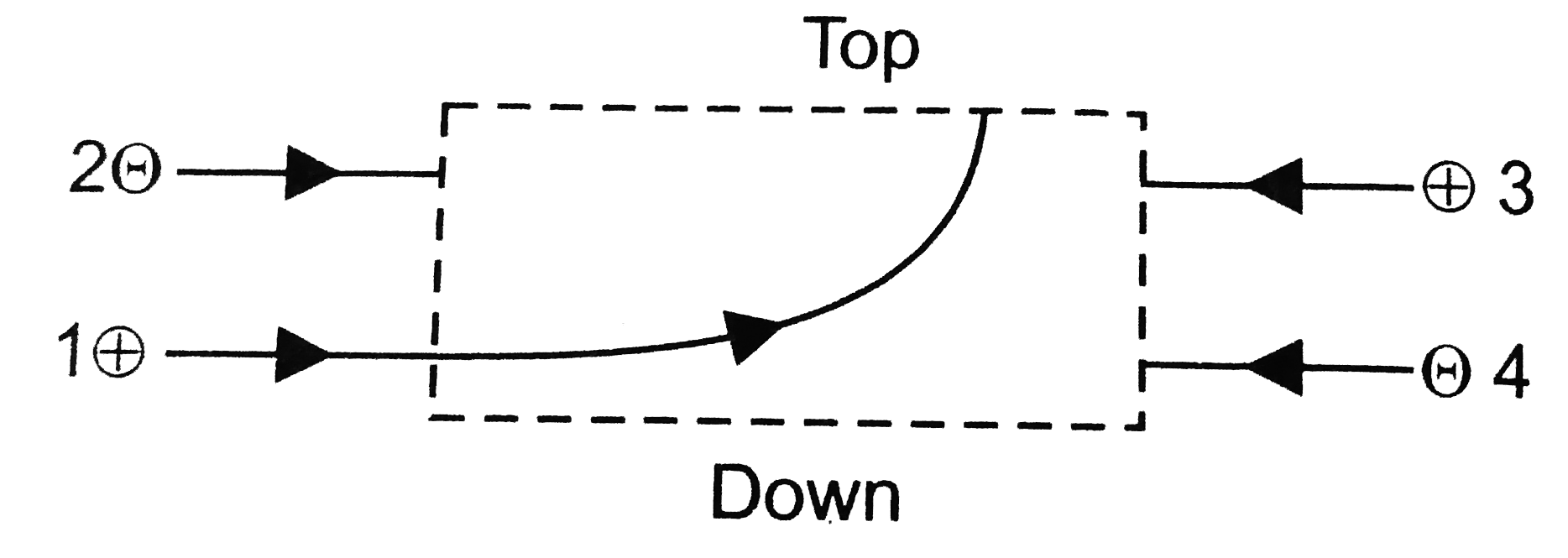
View SolutionThe electric intensity due to a dipole of length `10 cm` and having a charge of `500 muC`, at a point on the axis at a distance `20 cm` from one of the charges in air is
View SolutionTwo electric dipoles of moment `P` and `64P` are placed in opposite direction on a line at a distance of `25 cm`. The electric field will be zero at point between the dipoles whose distance from the dipole of moment `P` is
View SolutionTwo spherical conductors B and C having equal radii and cayying equal charges on them repel each other with a force F when kept apart at some distance. A third spherical conductor having same radius as that B but uncharged is brought in contact with B, then brought in contact with C and finally removed away from both. The new force of repulsion between B and C is
View SolutionA sample of HCl gas is placed in an electrical field of `3 xx 10^(4)NC^(-1)`. The dipole moment of each HCl molecule is `6 xx 10^(-30) C -m`. The maximum torque that can act on a molecule is
View SolutionA neutral water molecule `(H_(2)O)` in its vapor state has an electric dipole moment of magnitudes `6.4xx10^(-30)C-m`. How far apart are the molecules centers of positive and negative charge
View SolutionFigure shown below is a distribution of charges. The flux of electric field due to these charges through the surface S is
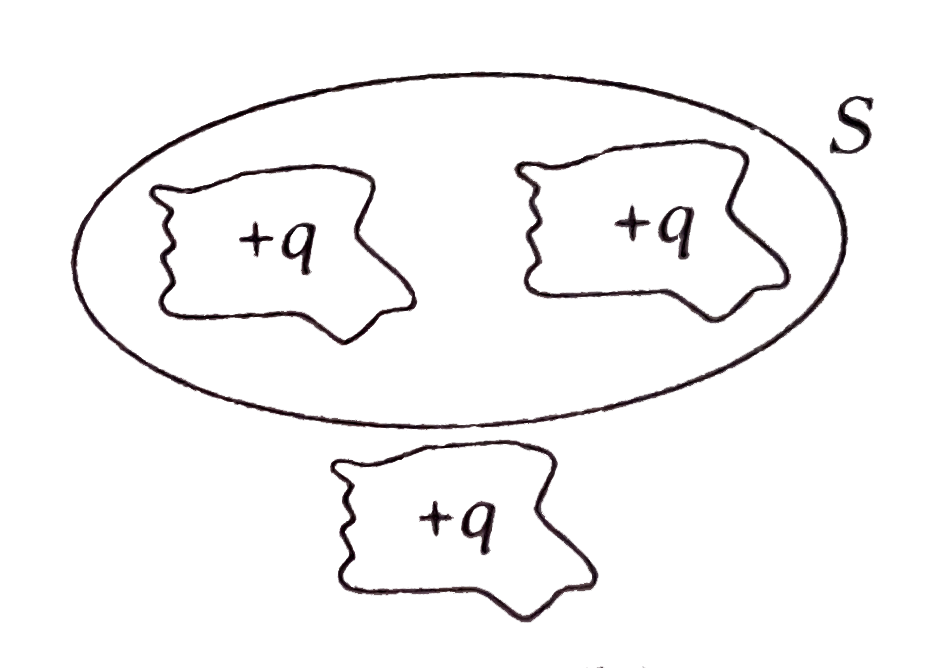
View SolutionThere exists an electric field of `1 NC^(-1)` along Y direction. The flux passing through the square of 1 m placed in `xy-`plane inside the electric field is
View SolutionTwo positive ions , each carrying a charge `q` , are separated by a distance `d`.If `F` is the force of repulsion between the ions , the number of electrons missing from each ion will be (`e` being the charge on an electron)
View SolutionAll charge on a conductor must reside on its outer surface.' This statement is true
View SolutionTwo charges `+4e` and `+e` are at a distance `x` apart. At what distance,a charge `q` must be placed from charge `+e` so that is in equilibrium
View SolutionAmong two discs A and B, first have radius 10 cm and charge `10^(-6) mu`C and second have radius 30 cm and charge `10^(-5)mu` C. When they are touched, charge on both `q_(A)` and` q_(B)` respectively will, be
View SolutionTwo charges are at a distance `d` apart. If a copper plate (conducting medium) of thickness `d//2` is placed between them , the effictive force will be
View SolutionTwo point charge `-q` and `+q//2` are situated at the origin and the point `(a,0,0)` respectively. The point along the `X`-axis where the electic field Vanishes is
View SolutionFive charges `q_(1),q_(2),q_(3),q_(4)andq_(5)` are fixed at their positions as shown in figure. S is Gaussian surface. The Gauss's law is given by `ointundersetSvecE*vec(ds)=q/epsilon_(0)`. Which of the following statements is correct?
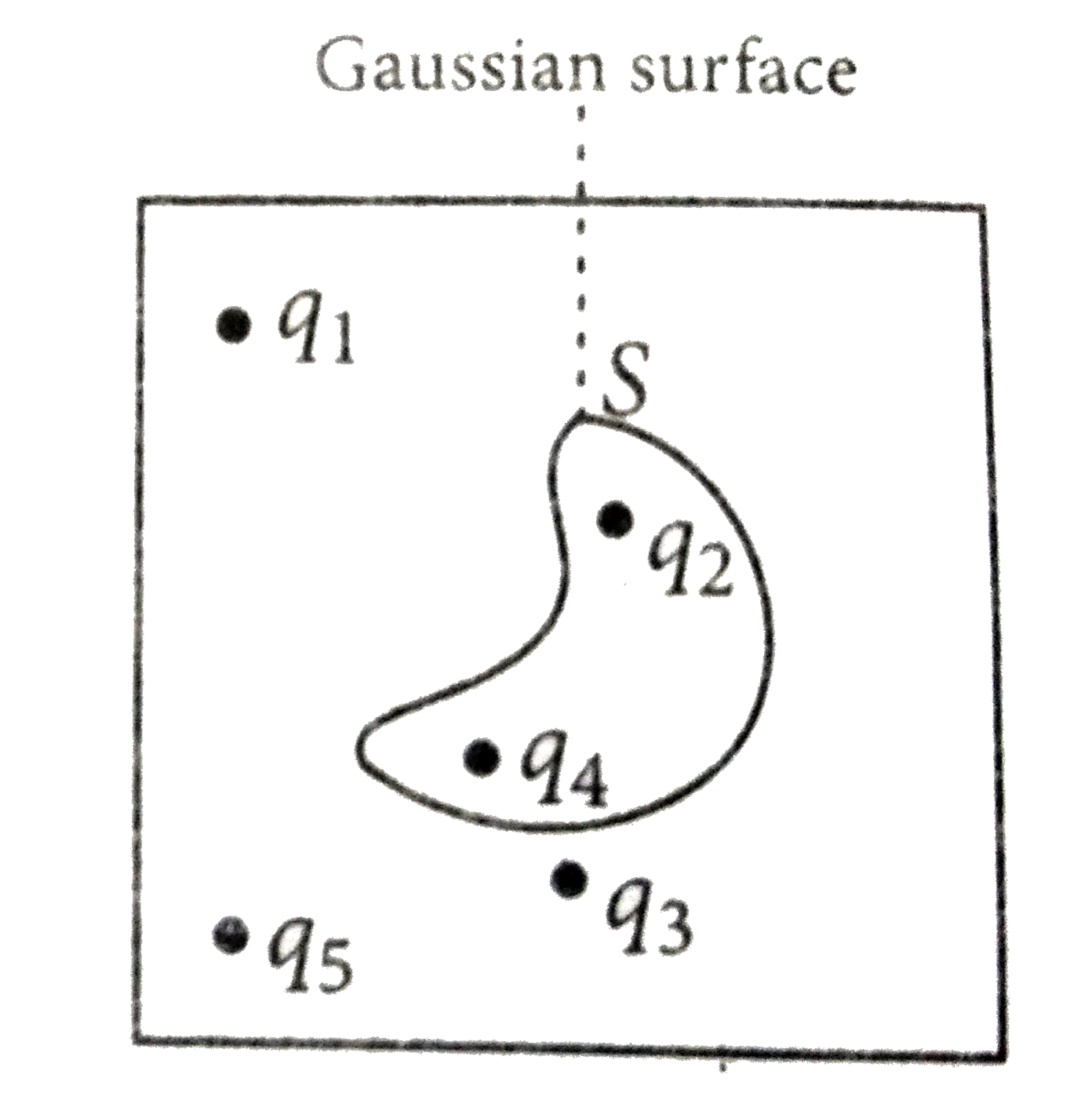
View SolutionIn figure two positive charges `q_(2)` and `q_(3)` fixed along the y-axis ,exert a net electric force in the `+x` direction on a charge `q_(1)` fixed along the x-axis if a positive charge `Q` is added at `(x,0)` the force on `q_(1)`
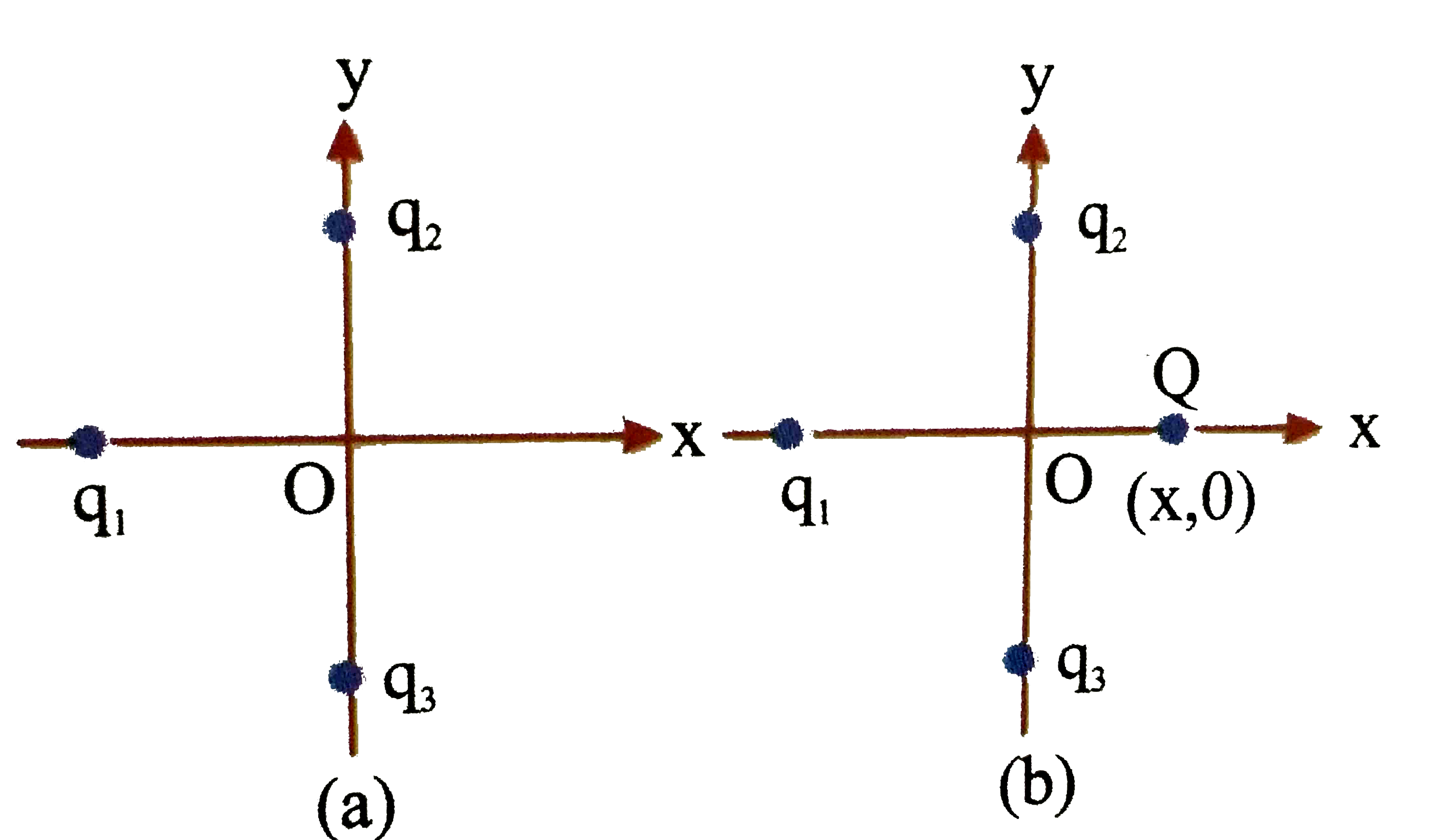
View SolutionA hemisphere is uniformly charged positively. The electric field at a point on a diameter away from the centre is directed
View SolutionA charge `q_0` is distributed uniformly on a ring of radius R. A sphere of equal radius R constructed with its centre on the circumference of the ring. Find the electric flux through the surface of the sphere.
View SolutionThree identical points charges, as shown are placed at the vertices of an isosceles right angled triangle. Which of the nembered vectors coincides in direction with the electric field at the mid-point `M` the hypotenuse
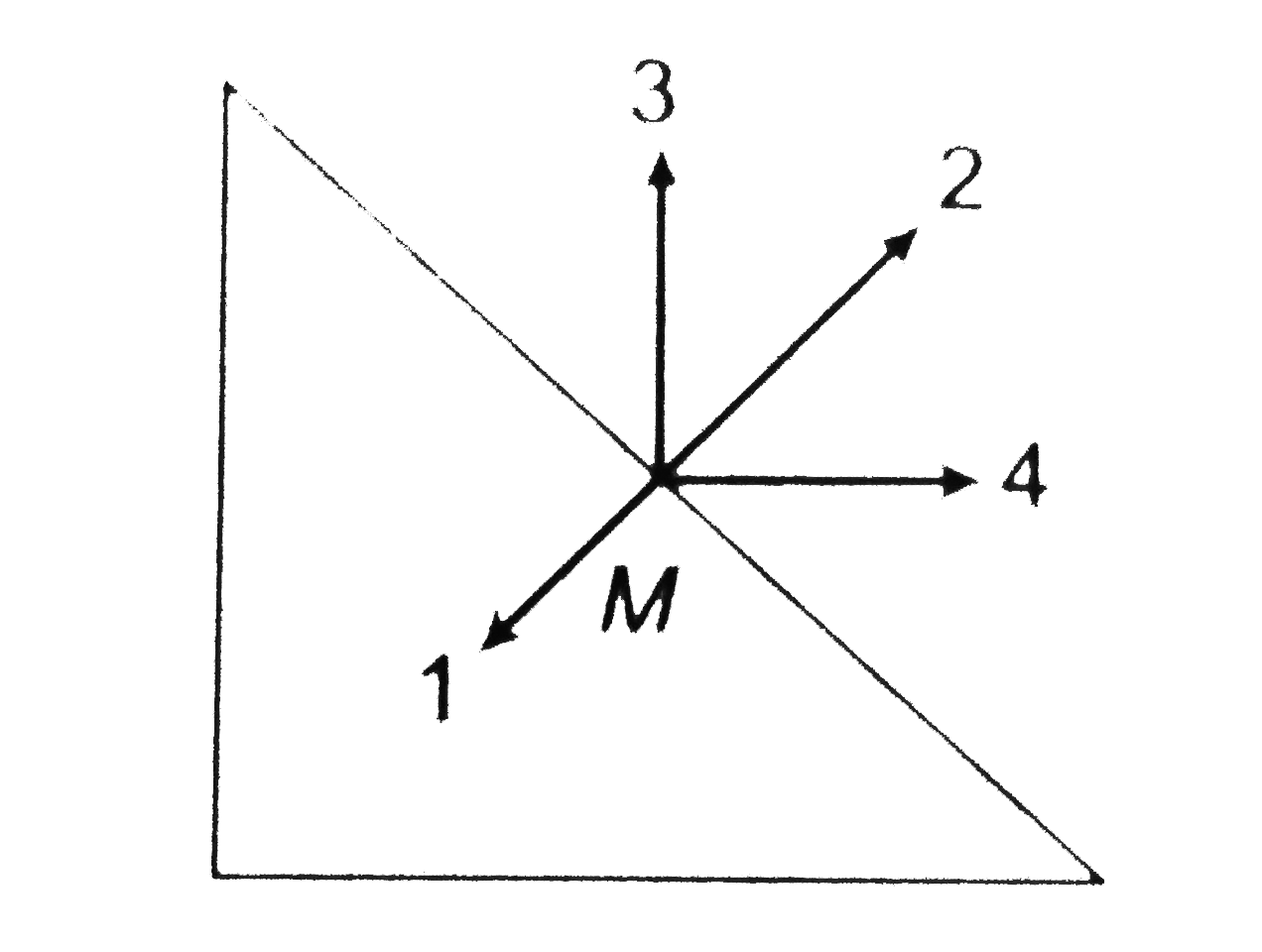
View SolutionTwo identical charged spheres of material density `rho`, suspended from the same point by inextensible strings of equal length make an angle `theta` between the string. When suspended in a liquid of density `sigma` the angle `theta` remains the same. The dielectric constant K of the liquid is
View Solution`ABC` is an equilateral triangle. Charges `+q` are placed at each corner. The electric intensity at `O` will be
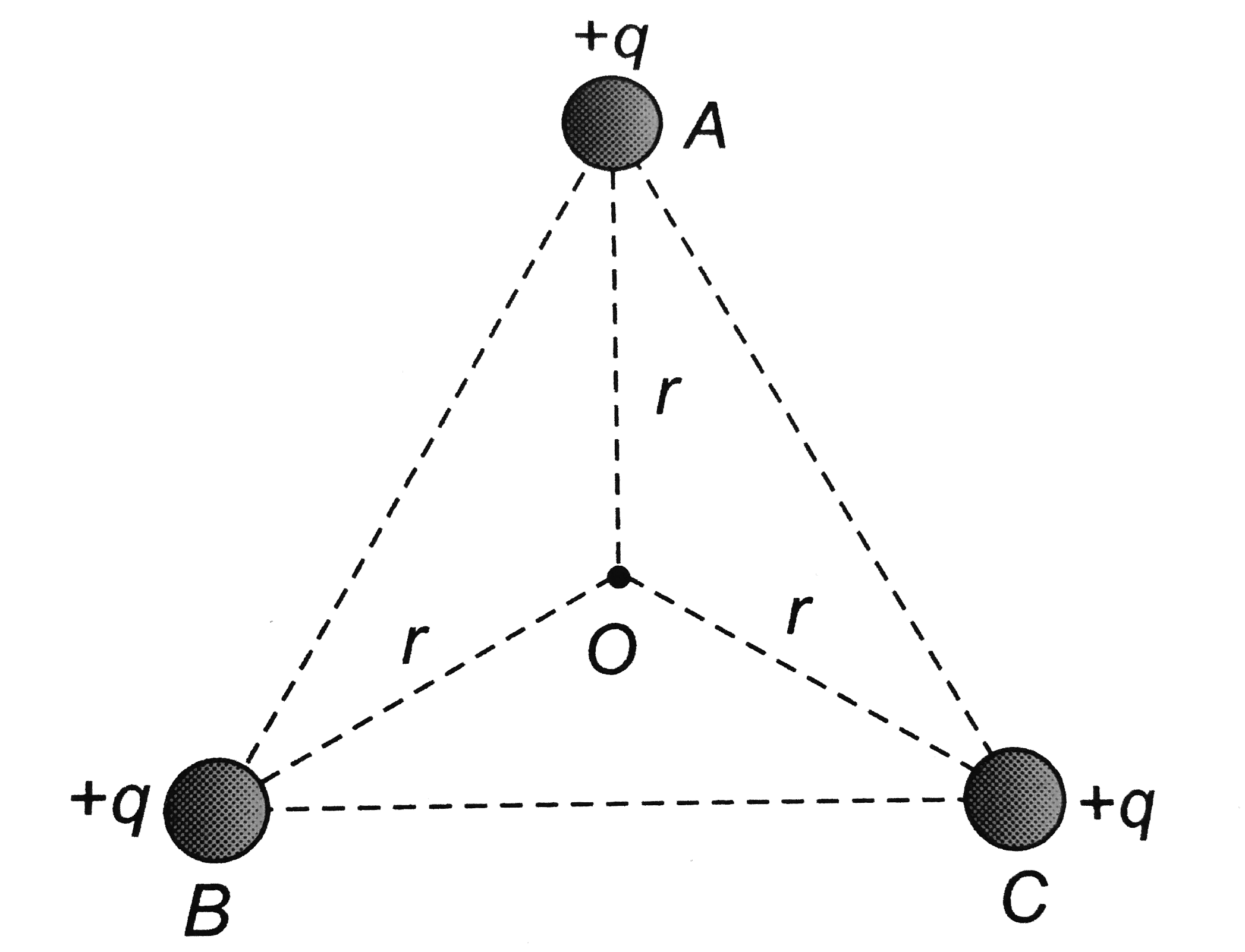
View SolutionA wire of linear charge density `lambda` passes through a cuboid of length l, breadth b and height h(l>b>h) in such a manner that the flux through the cuboid is maximum. The position of the wire is now changed, so that the flux through the cuboid is minimum. The raito of maximum flux to minimum flux will be
View SolutionEqual charges Q are placed at the four corners A, B, C, D of a square of length a. The magnitude of the force on the charge at B will be
View Solution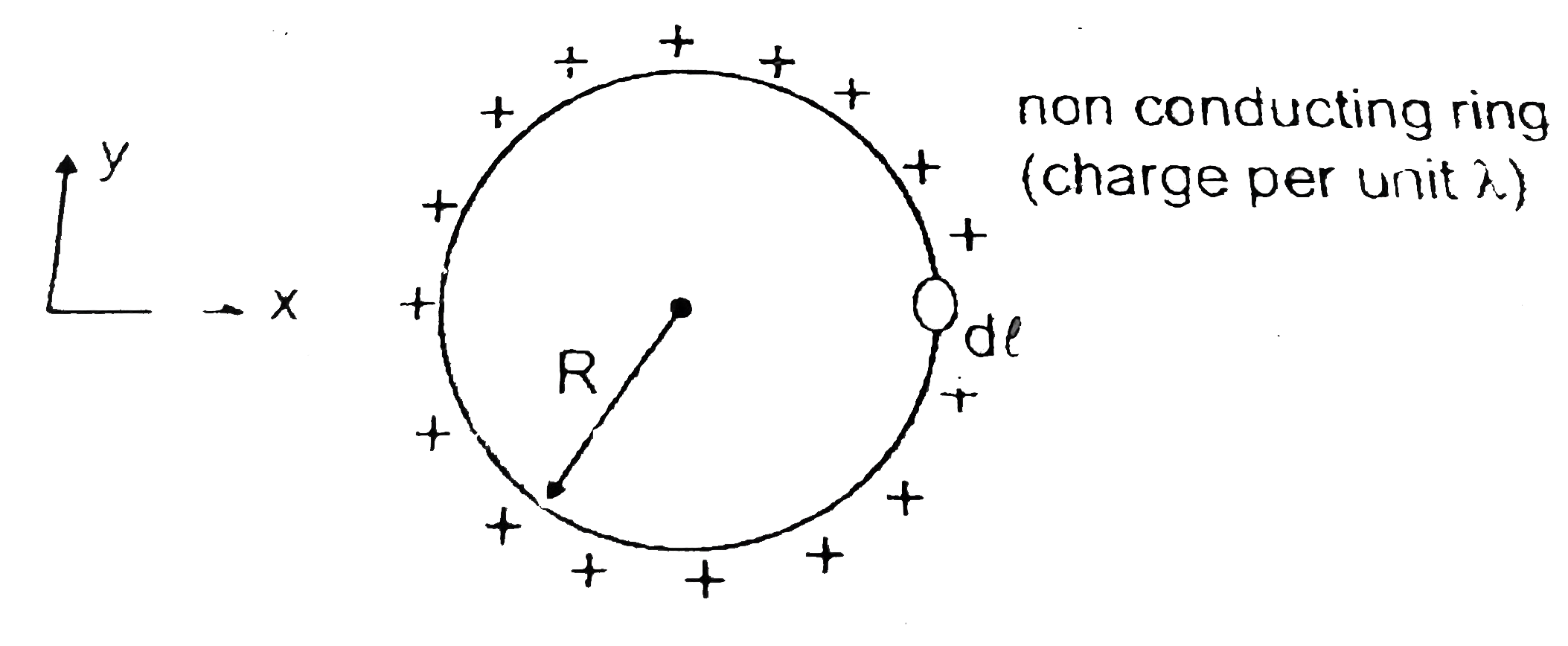
A small part of `dl` length is removed from a ring having charge per unit length `lamda`. Find electric field at centre due to remaining ring.
View SolutionTwo point charge `q_(1)=2muC` and `q_(2)=1muC` are placed at distance `b=1` and `a=2cm` from the origin on the `y` and `x` axes as shown in figure .The electric field vector at point `(a),(b)` will subtend on angle `theta` with the "x-axis" given by
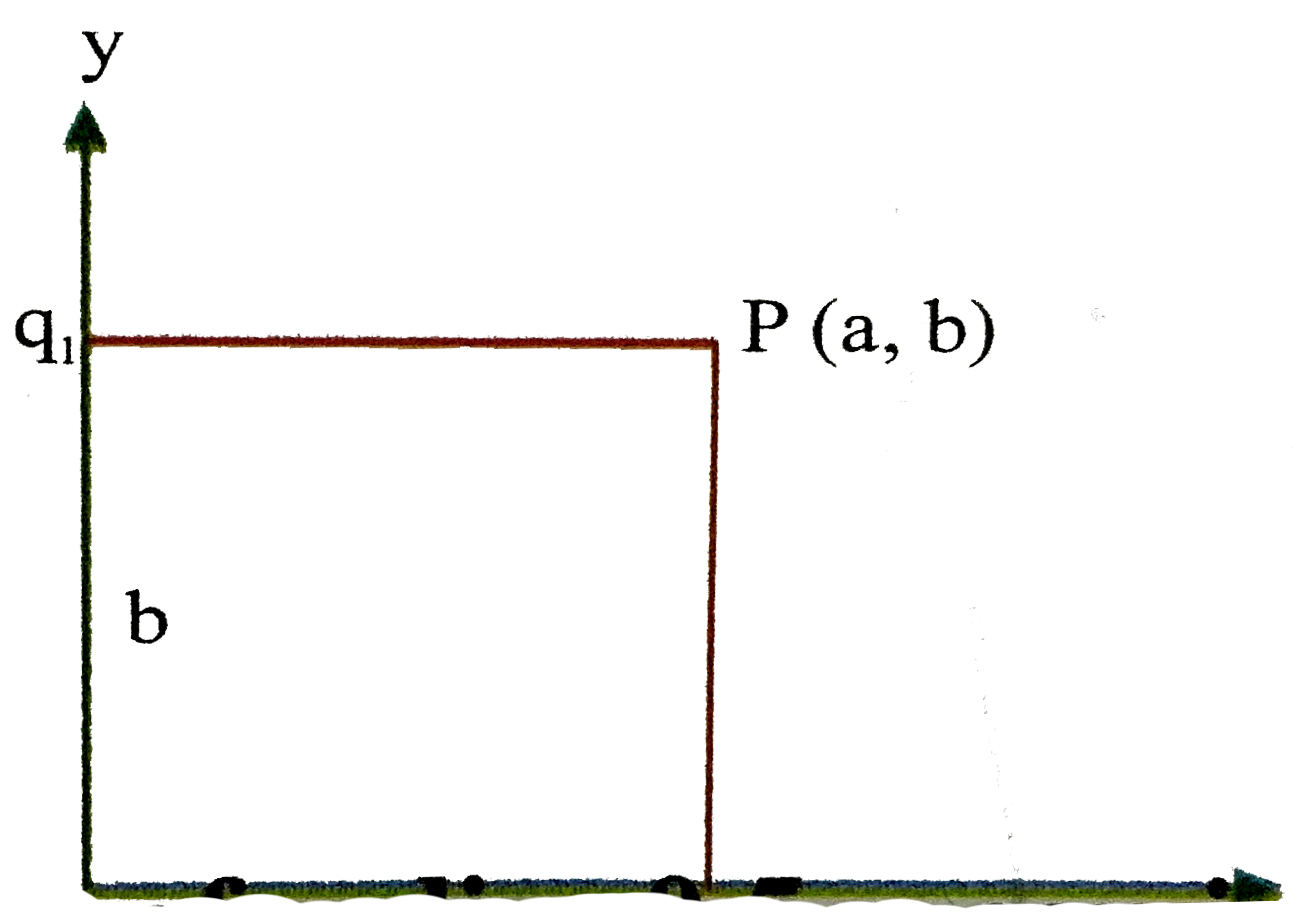
View SolutionTwo small spherical balls each carrying a charge `Q= 10 mu C` are suspended by two insulating threads of equal lengths `1 cm` each, from a point fixed in the ceiling. It is found that in equilibrium threads are sepreated by an angle `60^(@)` between them, as shown in figure. What is the tension in the threads
(Given `(1)/(4piepsilon_(0))= 9xx10^(9)Nm//C^(2)` )
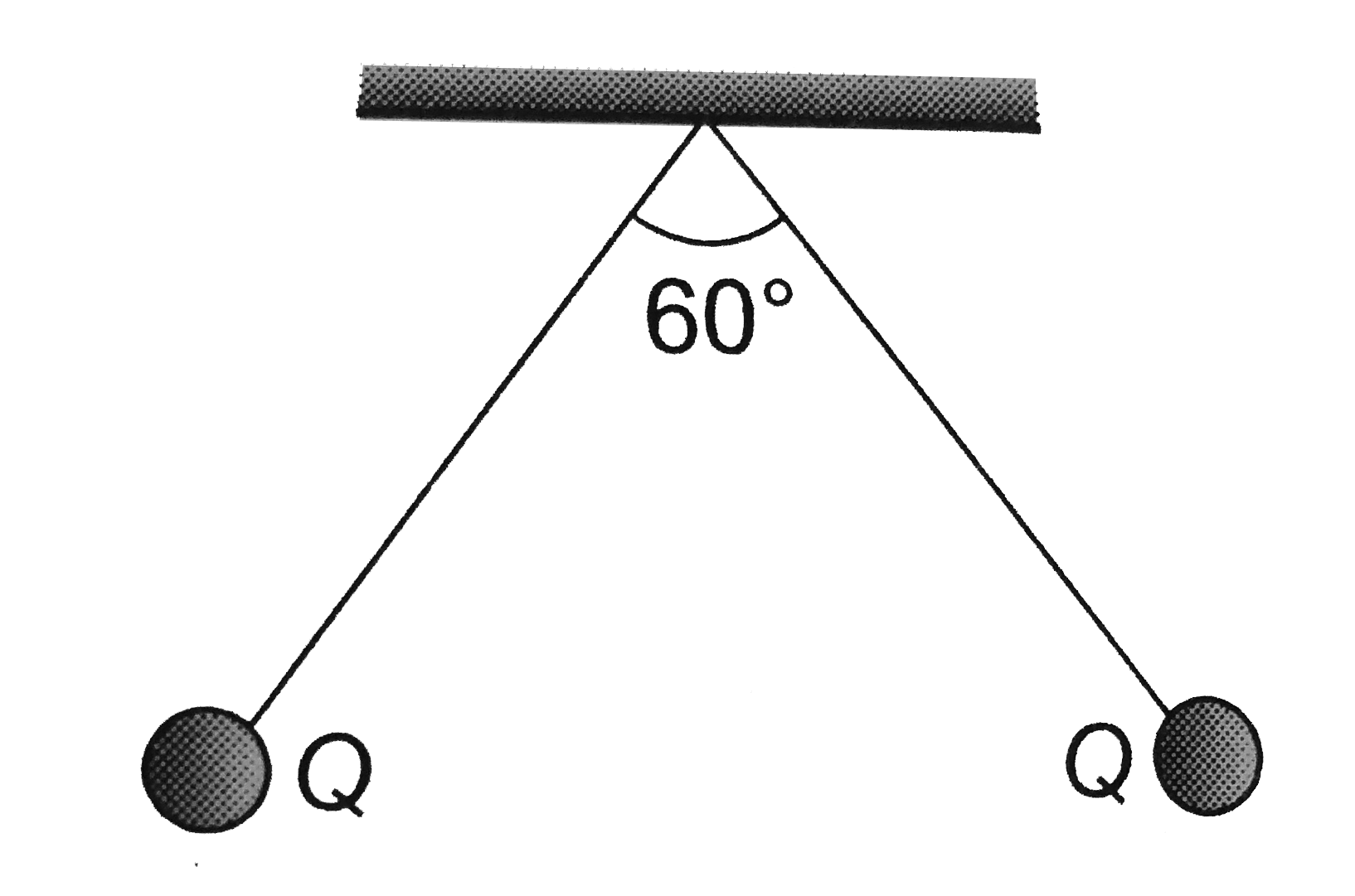
View SolutionAn infinite number of charges, each of charge `1 mu C` are placed on the `x`-axis with co-ordinates `x=1,2,4,8….oo` If a charge of `1C` is kept at the origin, then what is the net force action on `1C` charge
View SolutionAn electron moving with the speed `5xx10^(6)` per sec is shot parallel to the electric field of intensity `1xx10^(3)N//C`. Field is responsible for the retardation of motion of electron. Now evaluate the distance travelled by the electron before coming to rest for an instant (mass of `e= 9xx10^(-31)Kg` charge `= 1.6xx10^(-19)C)`
View SolutionAn electric dipole coincides on Z-axis and its mid-point is on origin of the coordinates system. The electric field at an axial point at a distance z from origin is `E_((z))` and electric field at an equatorial point at a distance y from origin is `E_((y))`. Here, `z = y gt gt a`, so `|(E_((z)))/(E_((y)))| =`... 1 4 3 2
View SolutionThree point charges `+q, -2q` and `+q` are placed at points `(x = 0, y =a, z =0),(x = 0, y = 0, z = 0)` and `(x = a, y = 0, z = 0)`, respectively. The magnitude and direction of the electric dipole moment vector of this charge assembly are
View SolutionA cylinder of radius R and length L is placed in a uniform electric field E parallel to the axis. The total flux for the surface of the cylinder is given by
View SolutionA charge `10 muC` is placed at the centre of a hemisphere of radius `R = 10 cm` as shown. The electric flux through the hemisphere (in MKS units)is

View SolutionElectric charge is uniformly distributed along a along straight wire of radius `1 mm`. The charge per centimeter length of the wire is `Q` coulomb. Another cyclindrical surface of radius `50 cm` and length `1 m` symmetrically enclose the wire ask shown in figure. The total electric flux passing through the cyclindrical surface is
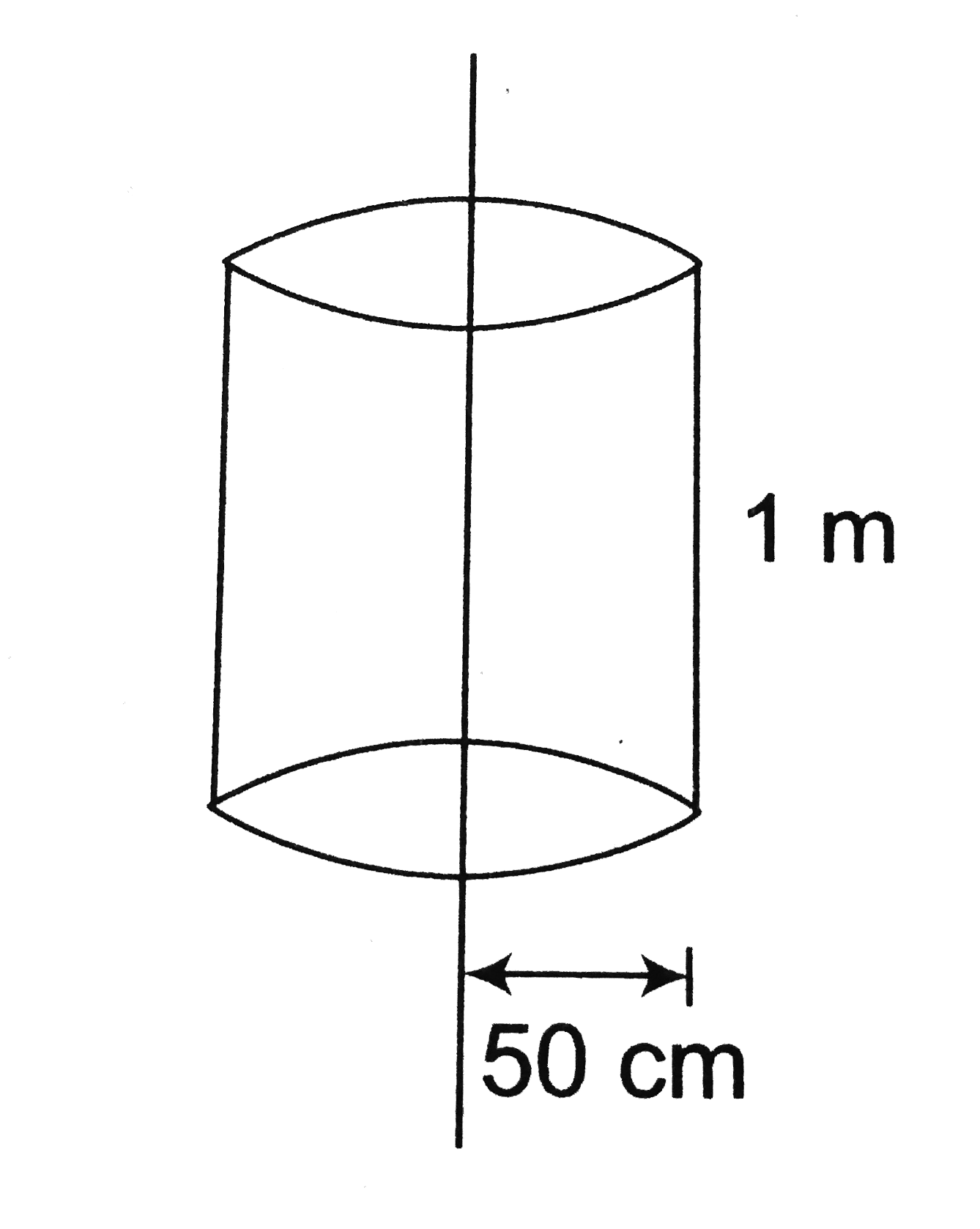
View SolutionA square surface of side `L m` is in the plane of the paper. A uniform electric field `vec(E )(V//m)`, also in the plane of the paper, is limited only to the lower half of the square surface (see figure). The electric flux in `SI` units associated with the surface is:
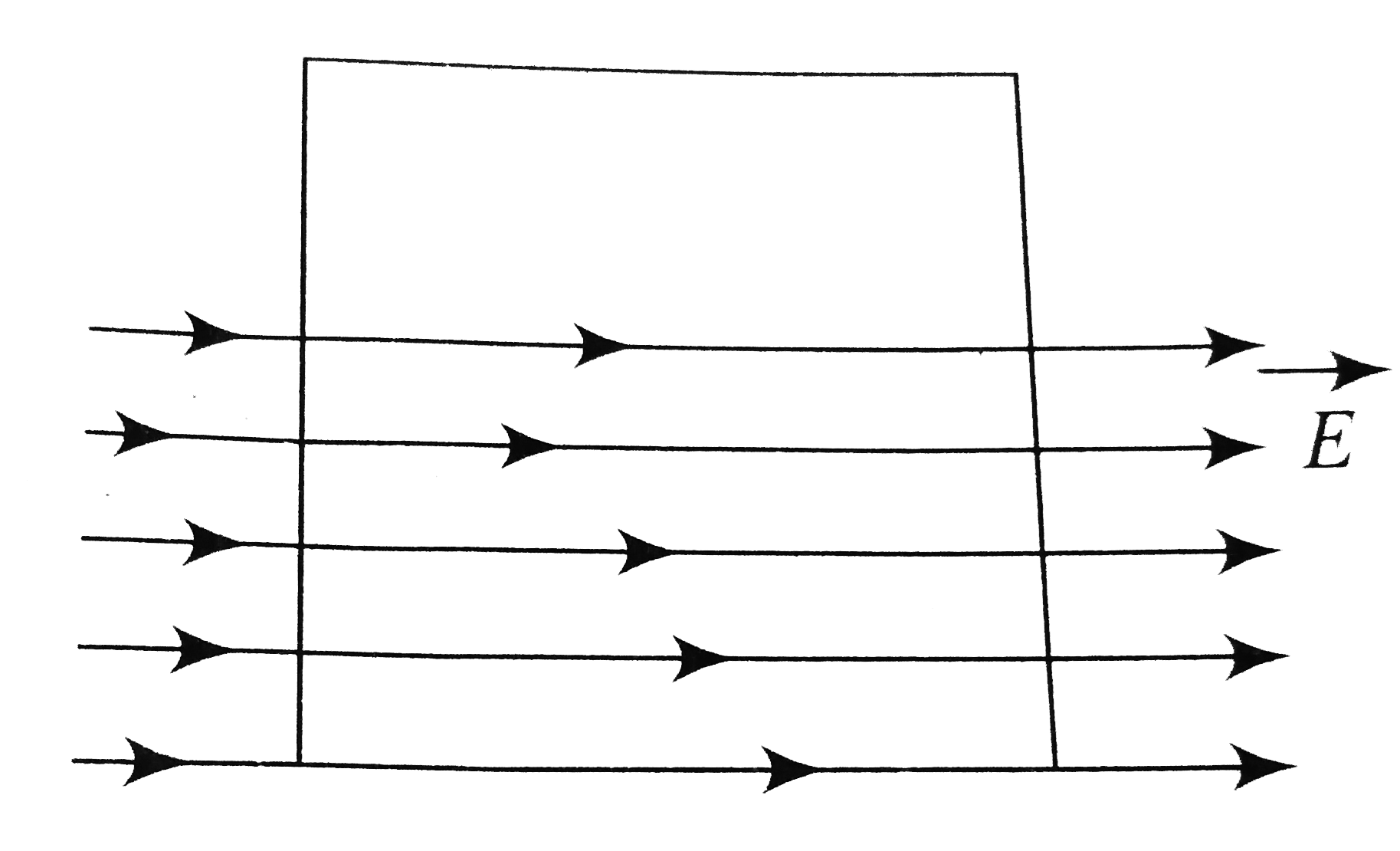
View SolutionWhich one of the following graphs represents the variation of electric field with distance r from the centre of a charged spherical conductor of radius R?
View SolutionIn a uniformly charged sphere of total charge Q and radius R, the electric field E is plotted as a function of distance from the centre. The graph which would correspond to the above will be
View SolutionAn electric dipole is situated in an electric field of uniform intensity `E` whose dipole moment is `p` and moment of inertia is `I`. If the dipole is displaced slightly from the equilibrium position, then the angular frequency of its oscilliations is
View SolutionTwo ppoint chargres `(+Q)` and the `(-2Q)` are fixed on the X-axis at positions a and 2a from origin respectively. At what positions on the axis, the electric field is zero
View SolutionCharge `q_(2)` of mass m revolves around a stationary charge `q_(1)` in a circulare orbit of radius r. The orbital periodic time of `q_(2)` would be
View SolutionFour charges equal to-Q are placed at the four corners of a square and a charge q is at its centre. If the system is in equilibrium the value of q is
View SolutionThe distance between the two charges `25 mu C` and `36 muC` is `11 cm`. At what point on the line joining the two, the intensity will be zero
View SolutionThe electric field at a point due to an electric dipole, on an axis inclined at an angle `theta ( lt 90^(@))` to the dipole axis, is perpendicular to the dipole axis, if the angle `theta` is
View SolutionIf `10^(10)` electrons are acquired by a body every second, the time required for the body to get a total charge of C will be
View SolutionABC is an equilateral triangle. Charges `-2q` are placed at each corner. The electric intensity at O will be
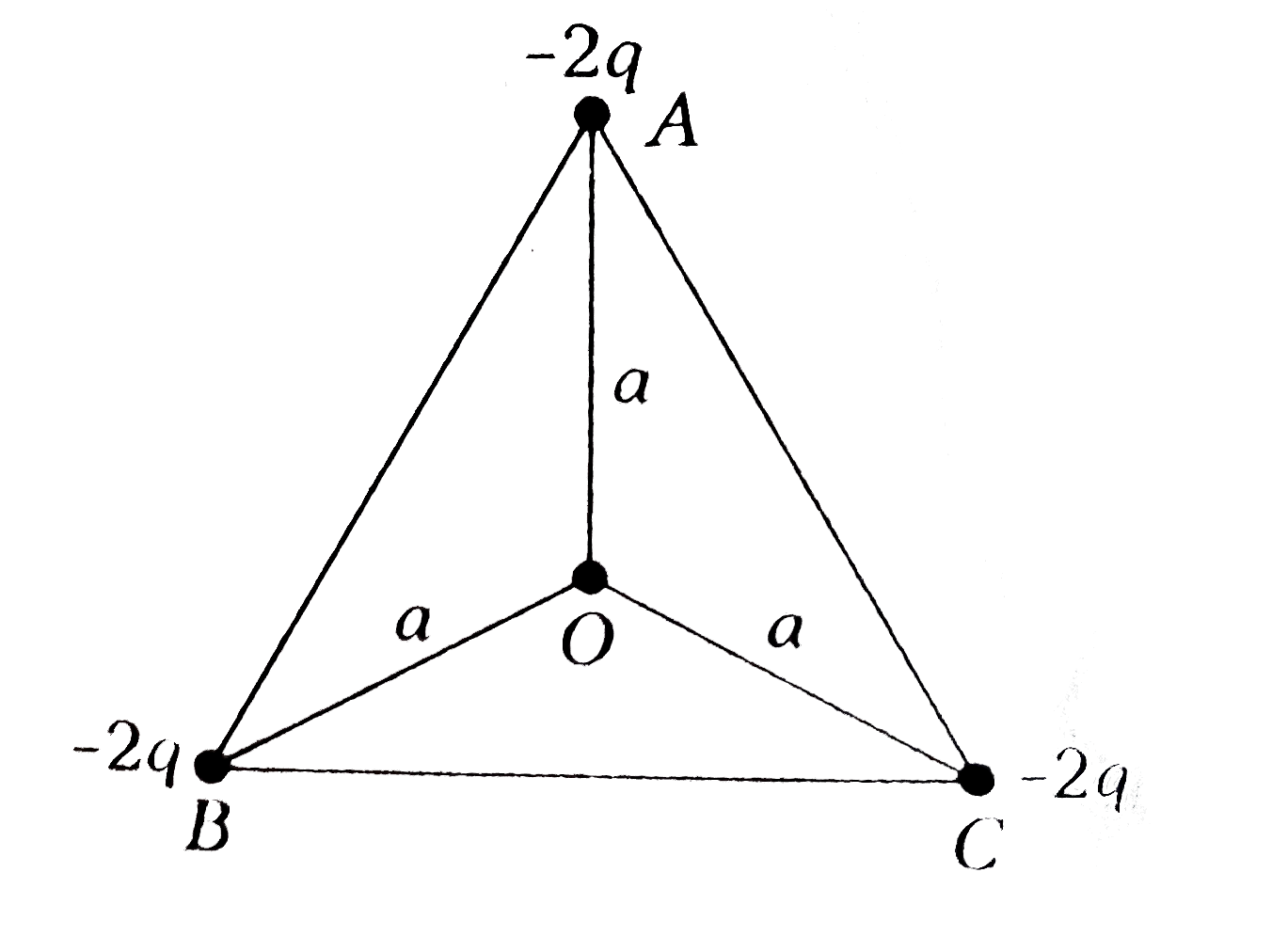
View SolutionTwo equally charged, indentical metal spheres `A` and `B` repel each other with a force `F"`. The spheres are kept fixed with a distance `r` between them. A third identical, but uncharged sphere `C` is brought in contact with `A` and removed. The magnitude of the net electric force on `A` is
View SolutionTwo point charges `+10^(-7) C` and `-10^(-7)C` are placed at A and B 20 cm apart as shown in the figure. Calculate the electric field at C, 20 cm apart from both A and B.

View SolutionInfinite charges of magnitude `q` each are lying at `x= 1,2,4,8….meter` on `X`-axis. The value of intensity of electric field at point `x=0` due to these charges will be
View SolutionTwo copper balls, each weighing `10 g` are kept in air `10 cm` apart. If one electron from every `10^(6)` atoms in trandferred from one ball to the other, the coulomb force between them is (atomic weight of copper is `63.5`)
View SolutionA wooden block performs SHM on a frictionless surface with frequency, `v_(0)`. The block carries a charge `+Q` on its surface. If now a uniform electric field `vec (E)` is switched on as shwon in figure., then the SHM of the block will be
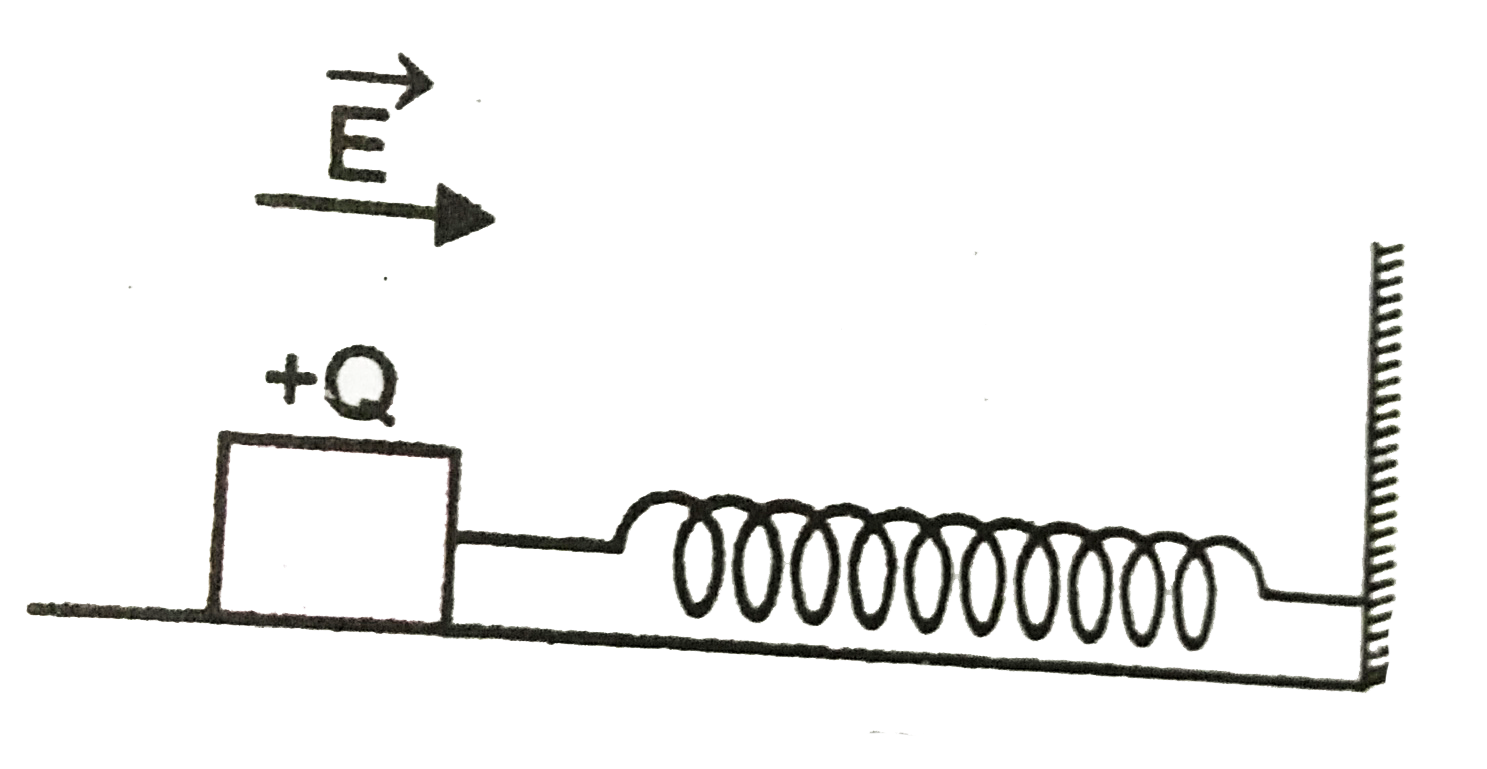
View SolutionA thin conducting ring of radius `R` is given a charge `+Q`, Fig. The electric field at the center `O` of the ring due to the charge on the part `AKB` of the ring is `E`. The electric field at the center due to the charge on part `ACDB` of the ring is
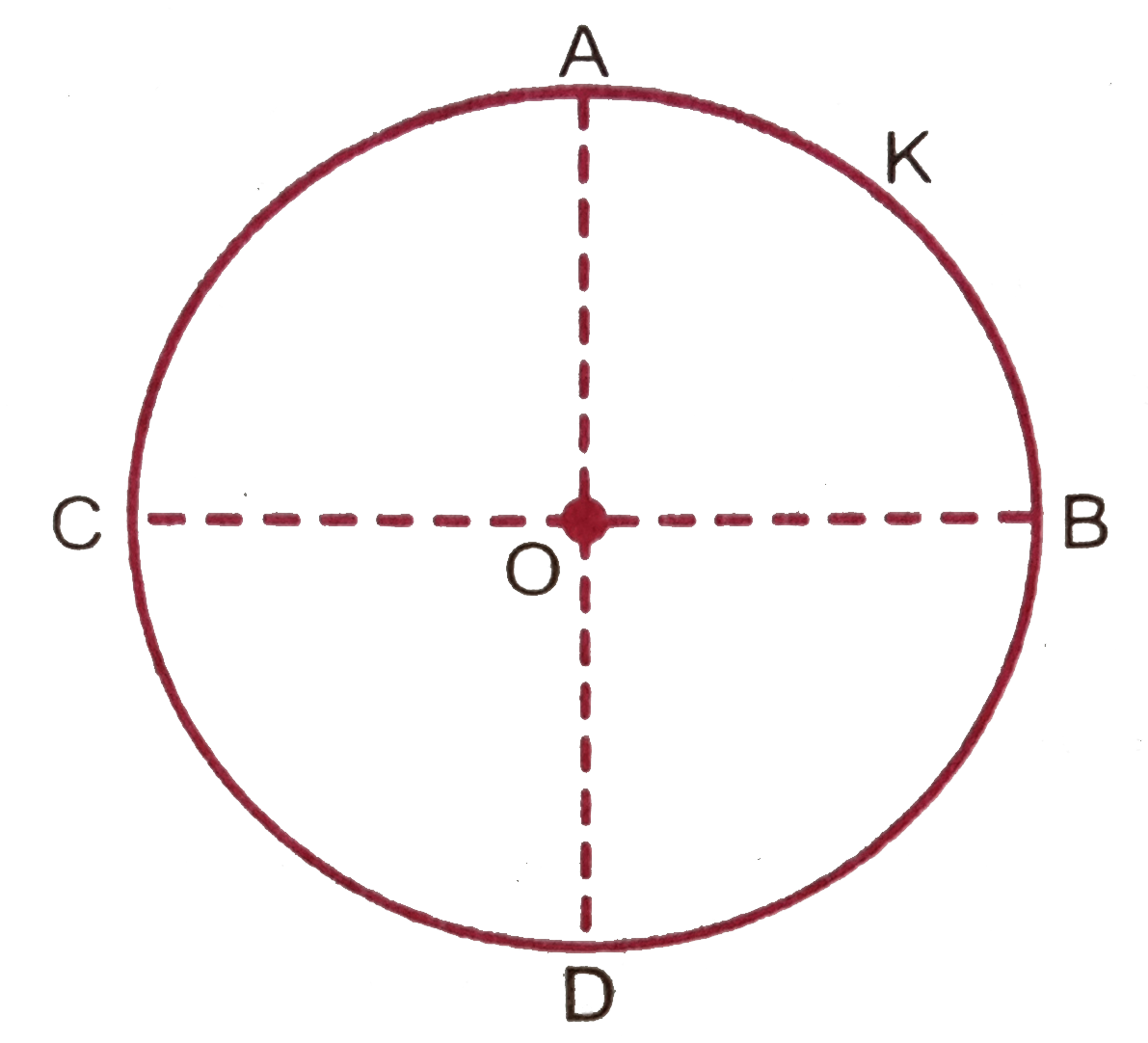
View SolutionFour point `+ve` charges of same magnitude`(Q)` are placed at four corners of a rigid square frame as shown in figure. The plane of the frame is perpendicular to `z`-axis. If a `-ve` point charge is placed at a distance `z` away from the above frame `(z lt lt L)` then
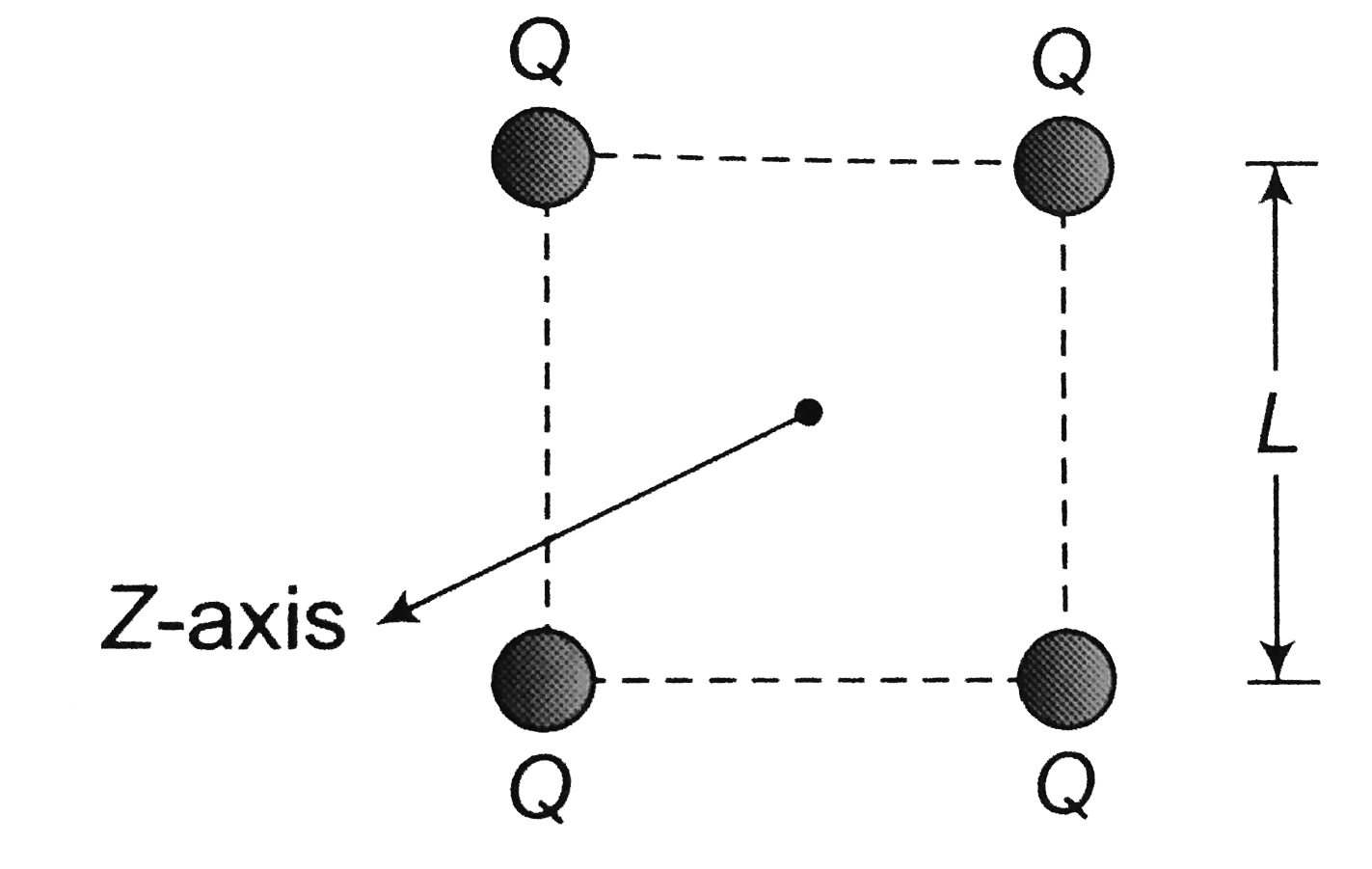 negative 1). charge oscillates along the Z-axis
2).it moves away from the frame
3).it moves slowly towards the frame and stays in the plane of the frame
4).it passes through the frame only once
negative 1). charge oscillates along the Z-axis
2).it moves away from the frame
3).it moves slowly towards the frame and stays in the plane of the frame
4).it passes through the frame only once
View SolutionA hollow cylinder has a charge `qC` within it. If `phi` is the electric flux in unit of voltmeter associated with the curved surface `B` the flux linked with the plance surface `A` in unit of voltmeter will be
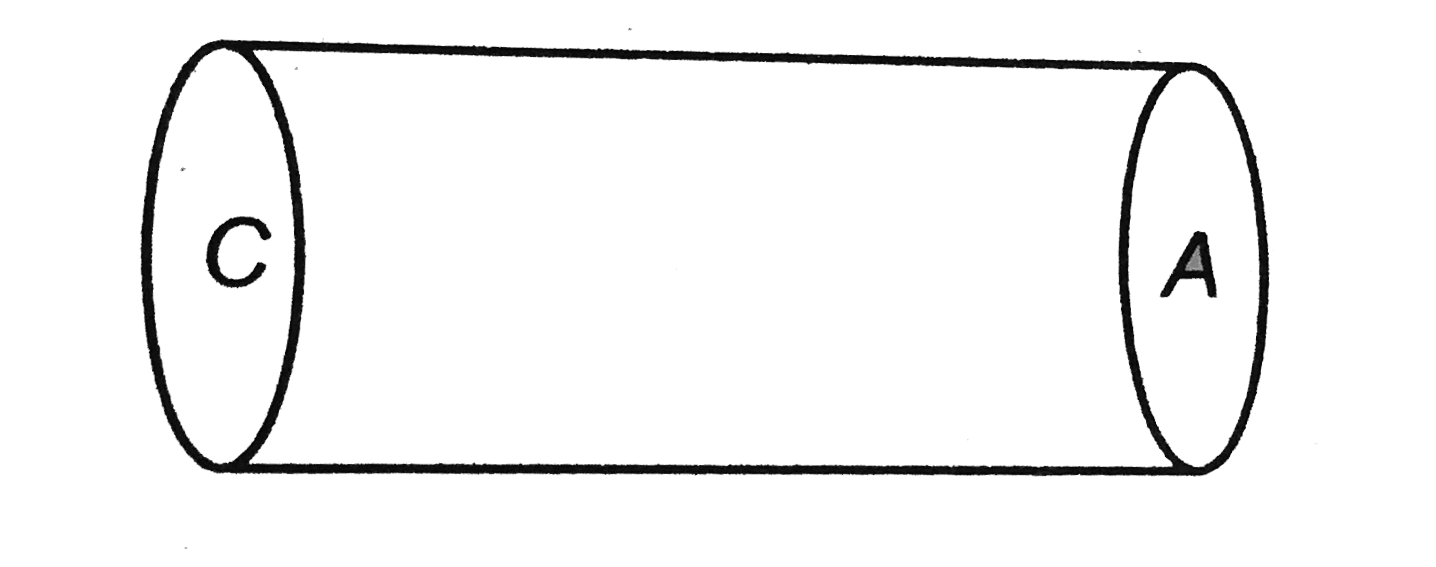
View SolutionThe adjacent diagram shows a charge `+Q` held on an insulating support `S` and enclosed by a hollow spherical conductor,`O` represent the center of the spherical conductors and `P` is a point such that `OP=x` and `SP=r` .The electric field at point `P` will be
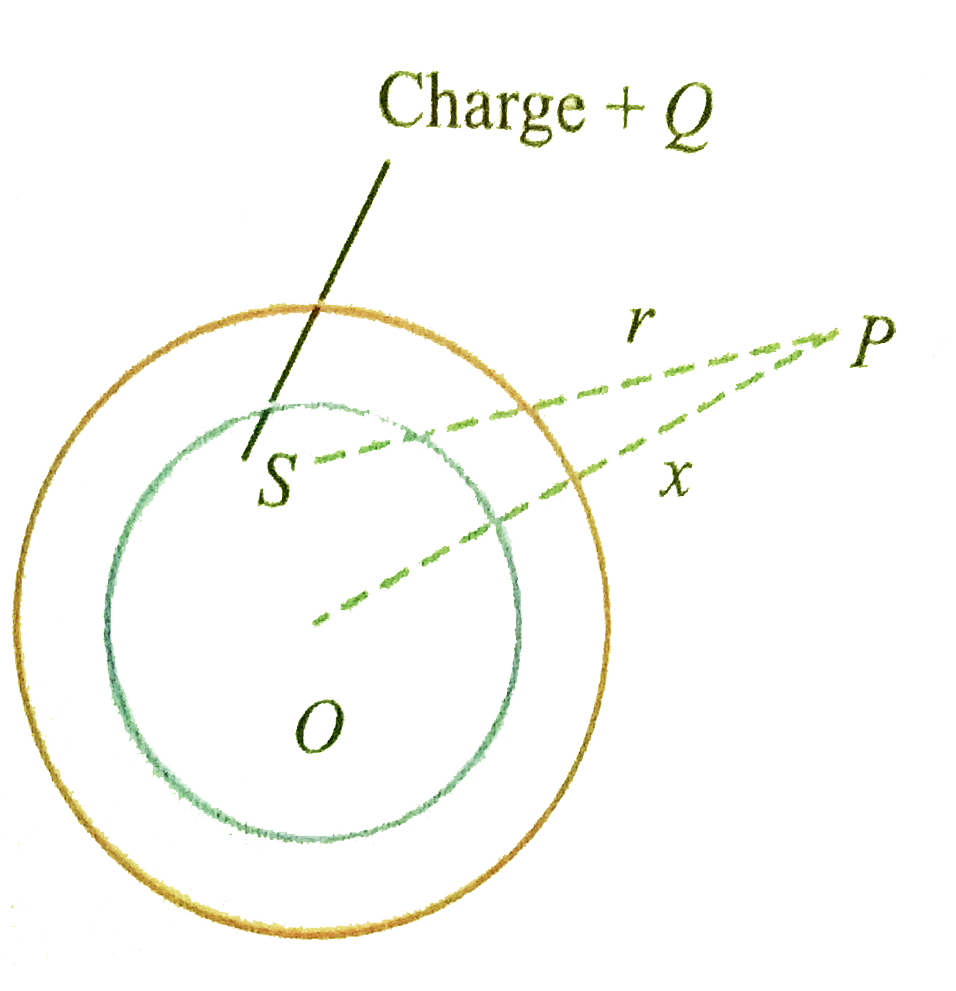
View SolutionAn infinitely long thin straight wire has uniform linear charge density of `1//3 "coul" m^(-1)` .Then the magnitude of the electric intensity at a point `18cm` away is
View SolutionTwo concentric conducting thin spherical shells A andB having radii rA and `r8 (r_(8) gt r_(A))` are charged to `Q_(A)` and `- Q_(B)(|Q_(B)| gt |Q_(A)|)`. The electric field strength along a line passing through the centre varies with the distance x as :
View SolutionTwo identical charged spheres suspended from a common point by two mass-less strings of length `l` are initially at a distance d ( `d ltlt l`) apart because of their mutual repulsion . The charge begins to leak from both the spheres at a constant rate. As a result the charge approach each other with a velocity `v`. Then as a function of distance `x` between them .
View Solution
Taking it together questions and complete solutions for chapter ELECTROSTATICS of DC PANDEY ENGLISH of Class 12
All Exercises from DC PANDEY NEET Class 12 PHYSICS ELECTROSTATICS
- Assertion and Reason
- Check point 1.1
- Check point 1.2
- Check point 1.3
- Check point 1.4
- Check point 1.5
- Example
- Example Type 5
- Example Type 6
- Example Type 8
- Exercise 24.1
- Exercise 24.2
- Exercise 24.3
- Exercise 24.4
- Exercise 24.5
- Exercise 24.6
- Exercise 24.7
- Level 1 Assertion And Reason
- Level 1 Objective
- Level 1 Subjective
- Level 2 Single Correct
- Match the columns
- Medical entrances gallery
- SUBJECTIVE_TYPE
- Taking it together